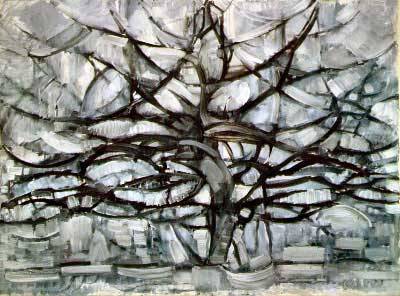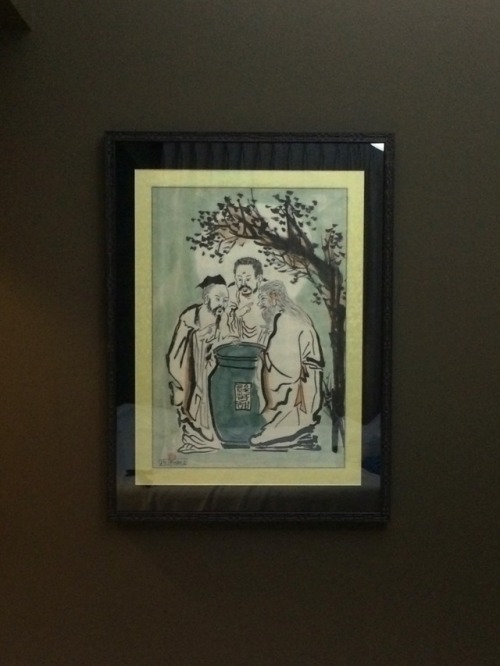#taoism
Plants
Like trees and flowers, plants symbolize death and resurrection; the life-force; the cycle of life.
Plant and flower symbolism is closely connected with the Great Mother, goddess of the earth, of fertility and vegetation; it is also associated with the fertility of the life-giving waters; the sap-filled plant is motherhood.
Plants and trees are often regarded as mythical ancestors and usually associated with the moon cult.
Plants or flowers which grow from the spilled blood of a god or hero represent the mystic union between man and plant and the birth of life from death, life flowing from one state to another, e.g. violets grew from the blood of Attis; wheat and herbs grew from the body of Osiris; and pomegranate from the blood of Dionysus, anemones from the blood of Adonis and red roses from the blood of Christ.
In Chinese symbolism the plant Polyporus lucidus is the plant of immortality and is the food of the Taoist genii or immortals.
[Source: An Illustrated Encyclopedia of Traditional Symbols by J.C. Cooper]
Post link
Beyond Taoism - Part 5
A Vector-based Probabilistic
Number System
Part II

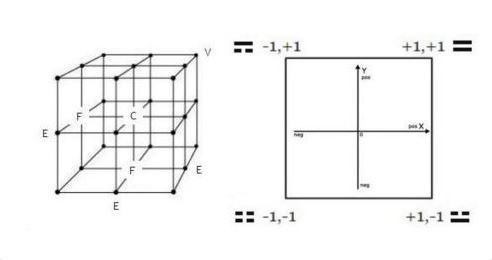
(continued from here)
Taoism and the primordial I Chingare in agreement that temporal changes have two different aspects: sequent and cyclic. Western thought in general follows suit. The I Ching differs from the other two in asserting that the direction of change - for both sequent and cyclic change - is fully reversible, with the proviso that sufficiently small units of measurement are involved.[1] The probability that reversal can be achieved diminishes proportionately to the magnitude of change that has taken place.[2]
Taoist appropriation of bigrams and trigrams of the I Ching to model such phenomena as change of seasons and phases of the moon is plausible if not quite legitimate. The natural phenomena so modeled are macroscopic and vary continuouslyandinexorably throughout an ever-repeating cyclic spectrum. And there’s the rub.

As they occur and function in the I Ching bigrams and trigrams are dicontinuous discrete elements, formed by other similarly discontinuous discretized entities, and they follow evolutionary courses which are most often nonrepetitive. So the Taoist usage is misleading at best, annihilative at worst. Unfortunately, as the I Ching itself evolved through centuries of commentaries and reinterpretations, it became ever more contaminated and tainted by these Taoist corruptions of meaning, at the same time that it was being inundated by Confucian sociological and ethical reworkings. What we have today is an amalgam, the various parts of which do not sit well with one another.[3]
Though it may in part be hyperbole to prove a point, the stark difference between the two approaches, that of Taoism and that of the I Ching, is epitomized by comparison of the Taoist diagram of the cycle of seasons with diagrams at the top and bottom of the page, which are based on the number, logic, and coordinate systems of The Book of Changes.[4] The increased complexity of the latter diagrams should not prove a stumbling block, as they can be readily understood in time with focus and attention to detail. The important take-away for now is that in the I Ching bigrams exist within a larger dimensional context than the Taoist diagram avows, and this context makes all their interactions more variable, conditional, and complex. As well, the same can be said of trigrams and hexagrams.
One of the more important aspects of these differences has to do with the notion of equipotentiality. As bigrams and trigrams function within higher dimensional contexts in the I Ching, this introduces a possibility of multiple alternative paths of movement and directions of change. Put another way, primordial I Ching logic encompasses many more degrees of freedom than does the logic of Taoism.[5] There is no one direction or path invariably decreed or favored. An all-important element of conditionality prevails. And that might be the origin of what quantum mechanics has interpreted as indeterminism or chance.
Next up, a closer look at equipotentiality and its further implications.
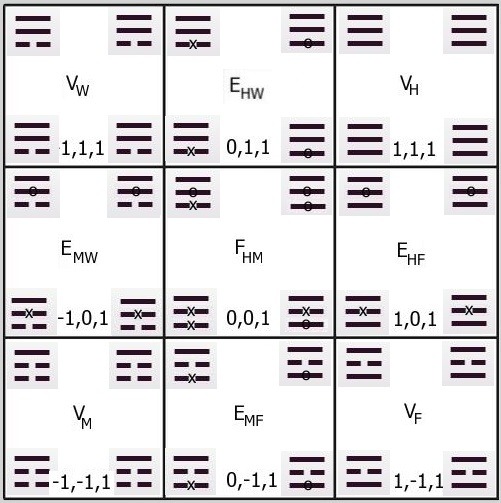
Section FH(n)[6]
(continuedhere)
Notes
[1] There are exceptions. Taoist alchemy describes existence of certain changes that admit reversibility under special circumstances. Other than the Second Law of Thermodynamics (which is macroscopic in origin, not result of any internally irreversible microscopic properties of the bodies), the laws of physics neglect all distinction between forward-moving timeandbackward-moving time. Chemistry recognizes existence of certain states of equilibrium in which the rates of change in both directions are equal. Other exceptions likely occur as well.
[2] Since change is quantized in the I Ching, which is to say, it is divided into small discretized units, which Line changes model, the magnitude of change is determined by the number of Line changes that have occurred between Point A and Point B in spacetime. Reversal is far easier to achieve if only a single Line change has occurred than if three or four Lines have changed for example.
[3] Ironically, Taoism itself has pointed out the perils of popularity. Had the I Ching been less popular, less appealing to members of all strata of society, it would have traveled through time more intact. Unless, of course, it ended up buried or burned. What is fortunate here is that much of the primordial logic of the I Ching can be reconstructed by focusing our attention on the diagrammatic figures and ignoring most of the attached commentary.
[4] These diagrams do not occur explicitly in the I Ching. The logic they are based on, though, is fully present implicitly in the diagramatic structural forms of hexagrams, trigrams, and bigrams and the manner of their usage in I Ching divinatory practices.
[5] Or, for that matter, than does the logic of Cartesian coordinate space if we take into account the degrees of freedom of six dimensional hexagrams mapped by composite dimensional methodology to model mandalic space. (See Note [4] here for important related remarks.)
[6] This is the closest frontal section to the viewer through the 3-dimensional cube using Taoist notation. See here for further explanation. Keep in mind this graph barely hints at the complexity of relationships found in the 6-dimensional hypercube which has in total 4096 distinct changing and unchanging hexagrams in contrast to the 16 changing and unchanging trigrams we see here. Though this model may be simple by comparison, it will nevertheless serve us well as a key to deciphering the number system on which I Ching logic is based as well as the structure and context of the geometric line that can be derived by application of reductionist thought to the associated mandalic coordinate system of the I Ching hexagrams. We will refer back to this figure for that purpose in the near future.
© 2016 Martin Hauser
Please note: The content and/or format of this post may not be in finalized form. Reblog as a TEXT post will contain this caveat alerting readers to refer to the current version in the source blog. A LINK post will itself do the same. :)
Scroll to bottom for links to Previous / Next pages (if existent). This blog builds on what came before so the best way to follow it is chronologically. Tumblr doesn’t make that easy to do. Since the most recent page is reckoned as Page 1 the number of the actual Page 1 continually changes as new posts are added. To determine the number currently needed to locate Page 1 go to the most recent post which is here. The current total number of pages in the blog will be found at the bottom. The true Page 1 can be reached by changing the web address mandalicgeometry.tumblr.com to mandalicgeometry.tumblr.com/page/x, exchanging my current page number for x and entering. To find a different true page(p) subtract p from x+1 to get the number(n) to use. Place n in the URL instead of x (mandalicgeometry.tumblr.com/page/n) where
n = x + 1 - p. :)
-Page 300-
Beyond Taoism - Part 4
A Vector-based Probabilistic
Number System
Introduction


(continued from here)
Leibniz erred in concluding the hexagrams of the I Ching were based on a number system related to his own binary number system. He had a brilliant mind but was just as fallible as the rest of us. He interpreted the I Ching in terms of his own thought forms, and he saw the hexagrams as a foreshadowing of his own binary arithmetic.[1]
So in considering the hexagram Receptive, Leibniz understood the number 0; in the hexagram Return, the number 1; in the hexagram Army, the number 2; in the hexagram Approach, the number 3; in the hexagram Modesty, the number 4; in the hexagram Darkening of the Light, the number 5; and so on, up to the hexagram Creative, in which he saw the number 63.[2] His error is perhaps excusable in light of the fact that the Taoists, though much closer to the origin of the I Ching in time, themselves misinterpreted the number system it was based on.[3]

From our Western perspectiveI Ching hexagrams are composed of trigrams, tetragrams, bigrams, and ultimately yinandyang Lines. From the native perspective of the I Ching this order of arrangement is putting the cart before the horse. Dimensions and their interactions are, in the view of I Ching philosophy and mandalic geometry, antecedent logically and materially to any cognitive parts we may abstract from them. Taoism in certain contexts has abstracted the parts and caused them to appear as if primary. It has the right to do so if creating its own philosophy, but not as interpretation of the logic of the I Ching. It is a fallacy if so intended.[4]
The Taoists borrowed from the I Ching two-dimensional numbers, treated them as one-dimensional and based their quasi-modular number system on the dimension-deficient result. This is the way they arrived at their seasonal cycle consisting of bigrams: old yin (Winter), young yang (Spring), old yang (Summer), young yin (Autumn), old yin (Winter), and so forth. This represents a very much impoverished and impaired version of the original configuration in the primal strata of the I Ching.[5]

The number system of the I Ching is not a linear one-dimensional number system like the positional decimal number system of the West; nor is it like the positional binary number system invented by Leibniz. It is not even like the quasi-modular number system of Taoism. The key to the number system of the hexagrams is located not in the 64 unchanging explicit hexagrams, but rather in the changing implicit hexagrams found only in the divination practice associated with the I Ching. These number 4032.[6] The manner in which these operate, however, is actually fairly simple and is uniform throughout the system. So once understood, they can be safely relegated to the implicit background, coming into play only during procedures involving divination or in attempts to understand the system fully, logically and materially. When dealing with more ordinary circumstances just the 64 more stable hexagrams need be attended to in a direct and explicit manner.
The Taoist sequence of bigrams is in fact a corruption of the far richer asequential multidimensional arrangement of bigrams that occurs in I Ching hexagrams and divination. There we see that change can occur from any one of the four stable bigrams to any other. If this is so then no single sequence can do justice to the total number possible. The ordering of bigrams presented by Taoism is just one of many that make up the real worlds of nature and humankind. Taoism imparts special significance to this sequence; the primal I Ching does not. It views all possible pathways of change as equally likely.[7]
Next time around we will look further into the implications of this equipotentiality and see how it plays out in regard to the number system of the I Ching.

Section FH(n)[8]
(continuedhere)
Notes
[1] By equating yang with 1 and yin with 0 it is possibletosequence the 64 I Ching hexagrams according to binary numbers 0 through 63. The mere fact that this is possible does not, however, mean that this was intended at the time the hexagrams were originally formulated. Unfortunately, this arrangement of hexagrams seems to have been the only one of which Leibniz had knowledge. This sequence was, in fact, the creation of the Chinese philosopher Shao Yong (1011–1077). It did not exist in human mentation prior to the 11th century CE.
This arrangement was set down by the Song dynasty philosopher Shao Yong (1011–1077 CE), six
centuries before Wilhelm Leibniz described binary notation. Leibniz published ‘De progressione
dyadica’ in 1679. In 1701 the Jesuit Joachim Bouvet wrote to him enclosing a copy of Shao Yong’s 'Xiantian cixu’ (Before Heaven sequence). [Source]
Note also that the author of Calling crane in the shade, the source quoted above, calls attention to confusion that exists about whether the “true binary sequence of hexagrams” should begin with the lowest line as the least significant bit (LSB) or the highest line. He points out that the Fuxi sequence as transmitted by Shao Yong in both circular and square diagrams takes the highest line as the LSB, although in fact it would make more sense in consideration of how the hexagram form is interpreted to take the lowest line as the LSB. My thinking is that either Shao Yong misinterpreted the usage of hexagram form or, more likely, the conventional interpretation of the Shao Yong diagrams is incorrect. Here I have chosen to use the lowest line of the hexagram as the LSB, and I think it possible Leibniz may have done the same.
If one considers the circular Shao Yong diagram, the easier of the two to follow, one can reconstruct the binary sequence, with the lowest line as LSB, by beginning with the hexagram EARTH at the center lower right half of the circle, reading all hexagrams from outside line (bottom) to inside line (top), progressing counterclockwise to MOUNTAIN over WIND at top center, then jumping to hexagram MOUNTAIN over EARTH bottom center of left half of the circle, and progressing clockwise to hexagram HEAVEN at top center. Of the two, this is the interpretation that makes the more sense to me and the one I have followed here, despite the fact that it is not the received traditional interpretation of the Shao Yong sequence. Historical transmissions have not infrequently erred. Admittedly it is difficult to decipher all Lines of some of the hexagrams in the copy Leibniz received due to passage of time and its effects on paper and ink. Time is not kind to ink and paper, nor for that matter to flesh and products of intellect.
In the final analysis, which of the two described interpretations is the better is moot because neither conforms to the logic of the I Ching which is not binary to begin with. Moreover, there is a third interpretation of the Shao Yong sequence that is superior to either described here. It is not binary-based. And why should it be? After all the Fuxi trigram sequence which Shao Yong took as model for his hexagram sequence is itself not binary-based. Perhaps we’ll consider that interpretation somewhere down the road. For now, the main take-away is that Leibniz, in his biased interpretation of the I Ching hexagrams made one huge mistake. Ironically, had he not some 22 years prior already invented binary arithmetic, this error likely would have led him to invent it. It was “in the cards” as they say. At least in certain probable worlds.
[2]ReceptiveandCreative are alternative names for the hexagrams EarthandHeaven, respectively. The sequence detailed can be continued ad infinitum using yin-yang notation, though of course this takes us beyond the realm of hexagrams into what would be, for mandalic geometry and logistics of the I Ching, domains of dimensions numbering more than six. Keep in mind here though that Leibniz was not thinking in terms of dimension but an alternative method of expressing the prevalent base 10 positional number system notation of the West. He held in his grasp the key to unlocking an even greater treasure but apparently never once saw that was so. This seems strange considering his broadly diversified interests and pursuits in the fields of mathematics, physics, symbolic logic, information science, combinatorics, and in the nature of space. Moreover, his concern with these was not just as separate subjects of investigation. He envisaged uniting all of them in a universal language capable of expressing mathematical, scientific, and metaphysical concepts.
[3] Earlier in this blog I have too often confused Taoism with pre-Taoism. The earliest strata of the I Ching belong to an age that preceded Taoism by centuries, if not millennia. Though Taoism was largely based on the philosophy and logic of the I Ching, it didn’t always interpret source materials correctly, or possibly at times it intentionally used source materials in new ways largely foreign to the originals. The number system of the I Ching is a case in point.
In the interest of full disclosure, I am not an expert in the history or philosophy of Taoism. Taoist philosophies are diverse and extensive. No one has a complete set or grasp of all the thoughts, practices and techniques of Taoism. The two core Taoist texts, the Tao Te ChingandChuang-tzu, provide the philosophical basis of Taoism which derives from the eight trigrams (bagua) of Fu Xi, c. 2700 BCE, the various combinations of which created the 64 hexagrams documented in the I Ching. The Daozang, also referred to as the Taoist canon, consists of around 1,400 texts that were collected c. 400, long after the two classic texts mentioned. What I describe as Taoist thought then is abstracted in some manner from a huge compilation, parts of which may well differ from what is presented here. Similar effects of time and history can be discerned in Buddhism, Christianity, Islam and secular schools of thought like Platonism,Aristotelianism,Humanism, etc.
[4] Recent advances in the sciences have begun to raise new ideas regarding the structure of reality. Many of these have parallels in Eastern thought. There has been a shift away from the reductionist view in which things are explained by breaking them down then looking at their component parts, towards a more holistic view. Quantum physics notably has changed the way reality is viewed. There are no certainties at a quantum level, and the experimenter is necessarily part of the experiment. In this new view of nature everything is linked and man is himself one of the linkages.
[5] It is not so much that this is incorrect as that it isextremelylimiting with respect to the capacities of the I Ching hexagrams. A special case has here been turned into a generalization that purports to cover all bases. This may serve well enough within the confines of Taoism but it comes nowhere near elaborating the number system native to the I Ching. We would be generous in describing it as a watered down version of a far more complex whole. Through the centuries both Confucianism and Taoism restructured the I Ching to make it conducive to their own purposes. They edited it and revised it repeatedly, generating commentary after commentary, which were admixed with the original, so that the I Ching as we have it today, the I Ching of tradition, is a hodgepodge of many convictions and many opinions. This makes the quest for the original features of the I Ching somewhat akin to an archaeological dig. I find it not all that surprising that the oracular methodology of consulting the I Ching holds possibly greater promise in this endeavor than the written text. The early oral traditions were preserved better, I think, by the uneducated masses who used the I Ching as their tool for divination than by philosophers and scholars who, in their writings, played too often a game of one-upmanship with the original.
[6] A Line can be either yin or yang, changing or unchanging. Then there are four possible Line types and six Lines to a hexagram. This gives a total of 4096 changing and unchanging hexagrams (46 = 4096). Since there are 64 unchanging hexagrams (26 = 64) there must be 4032 changing hexagrams (4096-64 = 4032).
[7] This calls to mind the path integral formulation of quantum mechanics which was developed in its complete form by Richard Feynman in 1948. See, for example, this description of the path integral formulation in context of the double-slit experiment, the quintessential experiment of quantum mechanics.
[8] This is the closest frontal section to the viewer through the 3-dimensional cube using Taoist notation. See here for further explanation. Keep in mind this graph barely hints at the complexity of relationships found in the 6-dimensional hypercube which has in total 4096 distinct changing and unchanging hexagrams in contrast to the 16 changing and unchanging trigrams we see here. Though this model may be simple by comparison, it will nevertheless serve us well as a key to deciphering the number system on which I Ching logic is based as well as the structure and context of the geometric line that can be derived by application of reductionist thought to the associated mandalic coordinate system of the I Ching hexagrams. We will refer back to this figure for that purpose in the near future.
© 2016 Martin Hauser
Please note: The content and/or format of this post may not be in finalized form. Reblog as a TEXT post will contain this caveat alerting readers to refer to the current version in the source blog. A LINK post will itself do the same. :)
Scroll to bottom for links to Previous / Next pages (if existent). This blog builds on what came before so the best way to follow it is chronologically. Tumblr doesn’t make that easy to do. Since the most recent page is reckoned as Page 1 the number of the actual Page 1 continually changes as new posts are added. To determine the number currently needed to locate Page 1 go to the most recent post which is here. The current total number of pages in the blog will be found at the bottom. The true Page 1 can be reached by changing the web address mandalicgeometry.tumblr.com to mandalicgeometry.tumblr.com/page/x, exchanging my current page number for x and entering. To find a different true page(p) subtract p from x+1 to get the number(n) to use. Place n in the URL instead of x (mandalicgeometry.tumblr.com/page/n) where
n = x + 1 - p. :)
-Page 299-
Quantum Naughts and Crosses Revisited - VIII
The Cube Sliced and Diced
Transliteration Series: Section FH(n)


(continued from here)
We come now to the Taoist/Cartesian transliteration sections of the three-dimensional cube.[1] The frontal FH section seen below is the Cartesian xy-plane we’re all familiar with from the 2-dimensional version of the Cartesian coordinate system with the third Cartesian dimension (z) added to the labeling of points. This gives us nine distinct Cartesian triad points: four vertices, four edge centers, and one face center. For all of the points, the third Cartesian dimension (z) is constant in this slice, and the vector value is positive (located toward the viewer with respect to the z=0 value of the z-axis or FHE plane which we’ll be viewing in a future post.)
The diagram shown here relates changing and unchanging trigrams of the I Ching to corresponding Cartesian ordered triads. Descartes views each of his ordered triads as referring to a single point having substantive reality in Cartesian geometric space. The I Ching and mandalic geometry, on the other hand, regard the trigrams as evanescent composite states of being in a spacetime which is ever-changing. They are relational elements in some ways analagous to the subatomic entities of particle physics.
Accordingly, it should be further understood each “point” here, though shown as a flat “square”, has a third dimension implied, and is therefore actually a “cube”, only one face of which is seen.[2] Mandalic geometry considers the point a fictional device which actually refers to a common intersection of three or more planes in a three-dimensional context, or two or more lines in a two-dimensional context. Moreover, mandalic geometry is a discretized geometry, and the trigram must be considered as having a distributed domain of action. This is illustrated in all the Cartesian transliteration points by distributing eight copies of trigrams with appropriate changing and unchanging lines among eight vertex-analogues of each Cartesian point.
The key to labeling of points in this section[3] and all those to follow can be found here. Additionally, by tradition, adding an “x” to a yin line indicates it is a changing line and adding an “o” to a yang line indicates it is a changing line. A changing yin line is considered an old yin line which is changing to a yang line; a changing yang line, an old yang line that is changing to a yinline.
Vector addition of two or more yinlines yields a yin line as result. Vector addition of two or more yang lines gives a yang line as the result. Vector addition of an unequal number of yin lines and yang lines yields as result that vector (yinoryang) in excess. Vector addition of an equal number of yin lines and yang lines gives as result Cartesian zero which, in mandalic systematics is to be considered a vector (direction) rather than a scalar (magnitude). This goes far in explaining how the I Ching and Taoism managed without an explicit zero.
Thezero was implicit or understood without using a special symbol of designation. Moreover, it was conceived as representative of an order of reality entirely different from that distinguished by the Western zero. It is, however, fully commensurate with Cartesian coordinate dynamics. It is this alternative zero, with its extraordinary capacities, that provides access to potential dimensions and to different amplitudes of dimension. This will be further elaborated in a future post where we will address how Boolean logic impacts what we’ve covered here.
For now simply note that the changing yin Line and changing yang Line in the horizontal first dimension (x) in each “point” shown in the middle column add to zero, not the zero of scalar magnitude though, but the zero of vector equilibrium.

Section FH(n)
In this section of the cube, as in all frontal sections, the third Line/dimension (z) never changes; the second Line/dimension (y) changes only in columns, as one progresses up or down; the first Line/dimension changes only in the rows, progressing left or right. This is just a consequence of viewing a two-dimensional Cartesian
xy-plane in context of a section of the three-dimensional Cartesian
xyz-cube. Although not the manner in which we are accustomed to viewing the plane, it is nonetheless fully compatible with ordinary Cartesian coordinates. It is simply an alternative perspective, one more suited for analysis/demonstration of trigram relationships in a Cartesian setting.
(continuedhere)
Notes
[1] This should be viewed as a work in progress. I’m still feeling my way with this so the content and/or format may change in the future. What is demonstrated here does not yet take into account the manner in which Boolean logic relates to the distribution of changing and unchanging trigrams nor does this series of cube sections include the all-important geometric method of composite dimension. As described, this is simply a Taoist notation transliteration of Cartesian coordinate structure. The meat and potatoes of the matter is yet to come. Of particular note here, though, is the fact that even at this early stage of translation to a version of mandalic geometry that can be considered comprehensive, what is possibly best described as a decussationbetweenyinandyang lines is already evident at every Cartesian triad point containing a “Cartesian zero”. Worth mentioning here, this will be a key feature addressed in future posts.
[2]Point, square, and cube, have all been placed in quotation marks to indicate that what is being referred to here is actually a different category of objects or elements which should in some sense be understood as relating to fractals or fractal structure and of a different dimensionality entirely than are those ordinary geometric objects. The admittedly deficient terminology used here is necessitated by the fact that sufficiently appropriate vocabulary terms to describe the reality intended do not currently exist, or if they do are not as yet known to me. Since we are representing a Cartesian point (ordered triad) as a quasi-cubic structure here, it must have a near face (n) and a far face (f) in each section with respect to the viewer. The chart displayed details the near face (n) of Section FH.
[3] This is the frontal section through the cube nearest a viewer. It is Descartes’ xy-plane with label of the third dimension (z) added so each point label shown is a Cartesian ordered triad rather than an ordered pair as textbooks generally show the plane. Why the difference? Because the geometry texts are interested only in demonstrating the two-dimensional plane in isolation, whereas we want to see it as it exists in the context of three or more dimensions. Cartesian triads are shown by convention as (x,y,z), so the xy-plane emerges from the first two coordinates of the points in this section, and all the z-coordinates seen here are positive (+1). The FE plane has all of its x and y coordinates identical to those seen here but its z-coordinates are all negative (-1). The FHE plane has all the x and y coordinates identical to those seen here but its z-coordinates are all zero (0).
© 2015 Martin Hauser
Please note: The content and/or format of this post may not be in finalized form. Reblog as a TEXT post will contain this caveat alerting readers to refer to the current version in the source blog. A LINK post will itself do the same. :)
Scroll to bottom for links to Previous / Next pages (if existent). This blog builds on what came before so the best way to follow it is chronologically. Tumblr doesn’t make that easy to do. Since the most recent page is reckoned as Page 1 the number of the actual Page 1 continually changes as new posts are added. To determine the number currently needed to locate Page 1 go to the most recent post which is here. The current total number of pages in the blog will be found at the bottom. The true Page 1 can be reached by changing the web address mandalicgeometry.tumblr.com to mandalicgeometry.tumblr.com/page/x, exchanging my current page number for x and entering. To find a different true page(p) subtract p from x+1 to get the number(n) to use. Place n in the URL instead of x (mandalicgeometry.tumblr.com/page/n) where
n = x + 1 - p. :)
-Page 296-
Beyond Taoism - Part 1
A Lost Logic of Chinese Antiquity

The 64 Hexagrams of the I Ching
(for interactive version click here)
(continued from here)
In speaking of “Taoist thought” I have often throughout this work used the term as a convenient shorthand for “primeval Chinese thought.” Strictly speaking, this usage is historically incorrect. Laozi is traditionally regarded as the founder of Taoism and is associated with “primordial” or “original” Taoism. Whether he actually existed is disputed. According to tradition the classic text attributed to him, the Tao Te Ching, was written around the 6th century BCE. The oldest extant text, however, dates to the late 4th century BCE. The earliest strata of the I Ching predate both these historical periods by many centuries, if not millennia. Taoism derived its cosmological notions from the philosophy of yin and yang, and from that of the Five Phases or Five Elements. Both these schools of thought were overwhelmingly influenced and shaped by exposure to the oldest known text of ancient Chinese classics, the I Ching.[1]
The actual symbolic logic of Taoism, although derived from the I Ching is extremely simplistic compared with that of the original upon which it is based. Whereas the philosophy of yinandyang as presented in the Tao Te Ching comprises little more than a two-dimensional cycle of two-valued elements, in the I Ching these two represent vectors in a six-dimensional combinatorial manifold of 64 hexagrams (1,2). Clearly, it is a difference like that between night and day. It is, in fact, a literal comparing of 22 with 26, the latter holding many more possibilities. The actual difference[2] in the logic and geometry emerging from the two is greater even than it appears at first. It eventuates not from just a simple geometric progression but from a mandalic intertwining and association of logical elements that give rise to different amplitudes of dimension as well as to a greater number of dimensions. This mandalic interweaving leads also to a richer catalogue of relationship types.[3]
Long viewed as mainly an ancient text of Chinese divination,theI Chingencompasses many more categories of thought - - - among them symbolic logic, geometry, and combinatorics. As a treatise which deals with combinatorics alone, it soars without equal, the first known compendium of combinatorial elements and still one of the finest. The logic and geometry that are embedded in the hexagram system of the I Ching are best understood in terms of dimensions and vectors akin to those in Cartesian systematics, and of logic gates analogous to the truth tables of Boolean algebra. And still the cognoscente will want to explore beyond the pertinency of these disciplines as also beyond Taoism to find the full meaning and intent of the I Ching.[4]
Having existed for millenia, and itself a treatise regarding change[5] in its many aspects, it would be inconceivable that the I Ching as we have it today is as it was in its beginnings. Popular at all societal levels through its entire existence, reinterpretations and reworkings have been myriad. Confucianism in particular interlaced its own brand of philosophical and “ethical-sociopolitical teachings” during and after the fifth century BCE. Other schools of thought added their unique perspectives to what became essentially a massive melting pot of schematization, one not always self-consistent by any means.
When one attempts to uncover the original face of the I Ching the difficulties encountered soon appear insurmountable. If involved in such a venture, it is imperative to bear in mind the bedrock strata of the work were in some ways more ingenuous, and in some more intricate, than the traditional version that has come down to us. The earliest layers arose in context of a preliterate oral tradition with all the many unique aspects of being that entails. In some ways the golden age of the I Ching ended with coming of the written word and literacy. The multidimensional logic that was readily accommodated by an oral tradition foundered and eventually was all but lost in the unrelenting techno-sociological onslaught of script with its associated inevitable linearity. Anyone who hopes to excavate the buried multidimensional logic of the primordial I Ching can expect to do a good deal of laborious digging.
(continuedhere)
Image:Source. Originally from Richard Wilhelm’s and Cary F. Baynes translation “I Ching: Or, Book of Changes” [3rd. ed., Bollingen Series XIX, (Princeton NJ: Princeton University Press, 1967, 1st ed. 1950)]
Notes
[1] Two diagrams known as bagua (or pa kua) that figure prominently in the I Ching and its Commentaries predate their appearances in the I Ching. The Lo Shu Square is sometimes associated with the Later Heaven arrangement of the bagua or trigrams, and the Yellow River Map is sometimes associated with the Earlier Heaven arrangement of trigrams. Both are linked to astronomical events of the sixth millennium BCE. Although part of Chinese mythology, they played an important role in development of Chinese philosophy. The Lo Shu Square is intimately connected with the legacy of the most ancient Chinese mathematical and divinatory traditions. The Lo Shu is the unique normal magic square (1,2) of order three (every normal magic square of order three is derived from Lo Shu by rotation or reflection). [Wikipedia]
[2] Taking into account both changing lines and unchanging lines of hexagrams there are four possible variants for each line: unchanging yin, unchanging yang, changing yin, and changing yang. This results in a total of 46 or 4096 possible different line combinations for each six-line figure. This allows for an enormous number of logical / geometric configurations, all of which map to various points of the mandalic cube or, in terms of Cartesian coordinates, to discretized points of the three-dimensional cube bounded by the eight Cartesian triads which have coordinates of +1 and/or -1 in all possible combinations (corresponding to the eight trigrams.)
To this point changing lines have not been discussed to avoid overcomplicating already complicated matters too soon. Changing lines play an indispensable role in all changes of yin lines to yang lines and vice versa, and therefore, in changes of one hexagram to another. They are also essential elements in formation of the geometric line segment generated by the I Ching hexagrams which I have earlier referred to as the "Taoist line“ and which we have yet to broach fully. Mandalic line segments uniformly comprise sixteen interrelated elements, hexagrams with changing and/or unchanging lines. Though various mandalic line segments have different compositions in terms of six-dimensional hexagrams, these hexagrams can always be reduced in logical and geometrical terms to sixteen bigram forms containing changing and/or unchanging lines. These bigram sets are all identical. No other variants are possible, since 42 equals 16. In this sense there is a single species of mandalic line segment but one which takes on different characteristics in different dimensional contexts. Every hexagram has a commentary appended to each of its six lines, which annotation is intended to be reflected upon only if the line is a changing one at time of consulting the oracle. Justly put, this system is brilliant beyond belief.
[3] Understand here that ‘relationship types’ may variously refer to human relationships in a society, to particle relationships in context of the atom, or to any other species of relationship one might imagine.
[4] For an exhaustive listing of linkstoI Ching related materials on the Web see here.
[5] Indeed, an alternative name of the I Ching in English is Book of Changes. The ensconced multidimensional logic encoded in the original work purports to be a microcosm describing all possible pathways of change, and their incessant changing relationships in the greater macrocosm of the universe.
© 2015 Martin Hauser
Please note: The content and/or format of this post may not be in finalized form. Reblog as a TEXT post will contain this caveat alerting readers to refer to the current version in the source blog. A LINK post will itself do the same. :)
Scroll to bottom for links to Previous / Next pages (if existent). This blog builds on what came before so the best way to follow it is chronologically. Tumblr doesn’t make that easy to do. Since the most recent page is reckoned as Page 1 the number of the actual Page 1 continually changes as new posts are added. To determine the number currently needed to locate Page 1 go to the most recent post which is here. The current total number of pages in the blog will be found at the bottom. The true Page 1 can be reached by changing the web address mandalicgeometry.tumblr.com to mandalicgeometry.tumblr.com/page/x, exchanging my current page number for x and entering. To find a different true page(p) subtract p from x+1 to get the number(n) to use. Place n in the URL instead of x (mandalicgeometry.tumblr.com/page/n) where
n = x + 1 - p. :)
-Page 295-
Beyond Boole - Part 1
Symbolic Logic for the 21st Century

Boolean Algebra:
Fundamental Operations
(continued from here)
Looking back on how we arrived at this stage of reconstruction of Western thought, I see the difficulty arose in attempting to explain the “missing zero” of Taoism. Blame our troubles on Leibniz. It was he who introduced binary numbers to the West, and made the fateful choice of using zero(0) instead of -1 to counter with +1. Leibniz knew full well of the I Ching, but did not understand it well. He missed the point, seeing in it only a resemblance to his own newly devised system of numbers.
By Leibniz’s time negative numbers were firmly entrenched in the European mind. Why did Leibniz ignore them completely? In doing so he blazed a new trail that led eventually to the digital revolution of recent times. It also led to a dead end in the history of Western thought, one the West has not yet come fully face to face with. It will, though. Give it a few more years.[1]
George Boole, the inventor of what we know today as Boolean logic or Boolean algebra, was one of the thinkers who followed in the footsteps of Leibniz, building on the trail he blazed.[2] When he came to devise his truth tables, he also chose zero(0) as the counterpart to one(1). This led to certain resounding successes. And ultimately, to certain failures that introduced yet another layer to the blind spot of Western symbolic logic. Here we are, almost two centuries later,[3] saddled with and hampered by the unfortunate fallout of that eventful decision still.[4]
Most arguments in elementary algebra denote numbers. However, in Boolean algebra, they denote truth values falseandtrue. Convention has decreed these values are represented with the bits (or binary digits), namely 0 and 1. They do not behave like the integers 0 and 1 though, for which 1 + 1 = 2, but are identified with the elements of the two-element field GF(2), that is, integer arithmetic modulo 2, for which 1 + 1 = 0. (1,2) This causes a substantial problem when we attempt correlation of Taoist logic and Boolean logic. As we will soon discover, Taoist logic is a hybrid logic that is based on both vector inversion and arithmetic modulo 2. As such, it ought prove relatable to both Cartesian coordinates and Boolean algebra, though it may necessitate “forcing a larger foot in a smaller glass slipper.”
Taoism chose ages ago to use ‘yin’ and 'yang’ as its logical symbols. Although this appears, at first, to be a binary system, like those of Leibniz and Boole, on closer inspection it proves not to be. It is one of far greater logical complexity, alternatively binary or ternary with intermediate third element understood. This implied third element is able to bestow balance and equilibrium throughout all of the Taoist logical system. This is where the 'missing zero’ of Taoism went. Only it is a very different zero than the 'zero’ of Western thought. It is a zero of infinite potential rather than one of absolute emptiness. It is a zero of continual beginnings and endings, not of finality. It is one of the things that make the I Ching totally unique in the history of human cognition. All these hidden zeros are wormholes between dimensions and between different amplitudes of dimension.
So where does this all lead to, then? We’ve seen that the Taoist 'yin’ can readily be made commensurate with 'minus 1’ of Western arithmetic, the number line, and Cartesian coordinates.[5] But if it is to remain true to Taoist logic, it cannot be made commensurate with the Western 'zero’. We’ve found the Taoist number system and geometry to be Cartesian-like but not Cartesian. Now we discover them to be Boolean-like, not Boolean. Sorry, Leibniz, they are not so much as remotely like your binary system. You were far too quick to disesteem the unique qualities of the I Ching.[6]
This all has far-reaching consequences for Western thought in general. Especially though, for symbolic logic, mathematics, and physics. More specifically for our purposes here it means that when we create our Taoist notation transliteration of Cartesian coordinates, we will need also to translate Boolean logic into terms compatible with Taoist thought, that is to say, from a two-value system based on '1s’ and '0s’ into a three-value system based on '1s’, ’-1s’, and the ever-elusive invisible balancing-act '0s’ of Taoism.[7] We turn to that undertaking next.
(continuedhere)
Image: Fundamental operations of Boolean algebra. Symbolic Logic, Boolean Algebra and the Design of Digital Systems. By the Technical Staff of Computer Control Company, Inc. Other logical operations exist and are found useful by non-engineer logicians. However, these can always be derived from the three shown. These three are most readily implementable by electronic means. The digital engineer, therefore, is usually concerned only with these fundamental operations of conjunction, disjunction, and negation.
Notes
[1] It is at times like this that I am thankful I am not a member of Academia. Were I so, I could not afford, from a practical standpoint, to make claims such as this. Tenure notwithstanding.
[2] A knowledge of the binary number system is an important adjunct to an understanding of the fundamentals of Symbolic Logic.
[3] If we look back far enough in time, it was the introduction of “zero” as a number and a philosophical concept that led us down this tangled garden path, though the history of human thought is nothing if not interesting.
[4] Far out speculative thought here: Were binary numbers and Boolean logic based on +1s and -1s instead of +1s and 0s, might it not be possible to construct today a software-based quantum computer requiring no fancy juxtapositions and superpositions of subatomic particles? Think on it for a while before dismissing the thought as irrational folly.
[5] More correctly expressed, it can be made commensurate with the domain of negative numbers, since it is a vector symbol, properly speaking, concerned only with direction, not magnitude.
[6] Unfortunately there is still little understanding of the true nature of the symbolic logic encoded in the I Ching, as exemplified by this quote:
The I Ching dates from the 9th century BC in China. The binary notation in the
I Ching is used to interpret its quaternary divination technique.
It is based on taoistic duality of yin and yang.Eight trigrams (Bagua) and a set of 64 hexagrams (“sixty-four” gua), analogous to the three-bit and six-bit binary numerals, were in use at least as early as the Zhou Dynasty of ancient China.
The contemporary scholar Shao Yong rearranged the hexagrams in a format that resembles modern binary numbers, although he did not intend his arrangement to be used mathematically. Viewing the least significant bit on top of single hexagrams in Shao Yong’s square and reading along rows either from bottom right to top left with solid lines as 0 and broken lines as 1 or from top left to bottom right with solid lines
as 1 and broken lines as 0 hexagrams can be interpreted as sequence from 0 to 63.
[Wikipedia]
It was this Shao Yong sequence of hexagrams (Before Heaven sequence) that Leibniz viewed six centuries after the Chinese scholar created it, so maybe he can be forgiven his error after all.
The more significant point here might be that an important Neo-Confucian philosopher, cosmologist, poet, and historian of the 11th century either was no longer able to access the original logic and meaning of the I Ching or, at the very least, was hellbent on reinterpreting it in a manner contradictory to its original intent. The latter is a distinct possibility, as Neo-Confucianism was an attempt to create a more rationalist secular form of Confucianism by rejecting superstitious and mystical elements of Taoism and Buddhism that had influenced Confucianism since the Han Dynasty (206 BC–220 AD).
[7] Taoist logic and mandalic geometry share some of the characteristics of both Cartesian coordinates and Boolean logic, but not all of either. Descartes’ system is indeed a ternary one when viewed in terms of vector direction rather than scalar magnitude. That fits with the requirements of Taoist logic. It is, on the other hand, dimension-poor, as Taoist logic and geometry require a full six independent dimensions for execution. Boolean logic lacks the necessary third logical element -1, which causes inversion through a central point of mediation. But we shall see, it does bestow the ability to enter and exit a greater number of dimensional levels by means of its logical gates. Used together in an appropriate manner, these two can provide a key to understanding Taoist logic and geometry. Speculating even further, Taoist thought might provide a key to interpretation of quantum mechanics, the same quantum mechanics devised in the early twentieth century that no one can yet explain. Well, I mean, actually, Taoist thought in the formulation given it by mandalic geometry. Why feign modesty, when this work will likely linger in near-total obscurity for the next hundred years gathering dust or whatever it is that pixels gather in darkness undisturbed.
© 2015 Martin Hauser
Please note: The content and/or format of this post may not be in finalized form. Reblog as a TEXT post will contain this caveat alerting readers to refer to the current version in the source blog. A LINK post will itself do the same. :)
Scroll to bottom for links to Previous / Next pages (if existent). This blog builds on what came before so the best way to follow it is chronologically. Tumblr doesn’t make that easy to do. Since the most recent page is reckoned as Page 1 the number of the actual Page 1 continually changes as new posts are added. To determine the number currently needed to locate Page 1 go to the most recent post which is here. The current total number of pages in the blog will be found at the bottom. The true Page 1 can be reached by changing the web address mandalicgeometry.tumblr.com to mandalicgeometry.tumblr.com/page/x, exchanging my current page number for x and entering. To find a different true page(p) subtract p from x+1 to get the number(n) to use. Place n in the URL instead of x (mandalicgeometry.tumblr.com/page/n) where
n = x + 1 - p. :)
-Page 294-
Beyond Descartes - Part 10
Taoism Meets Boolean Logic: Introduction
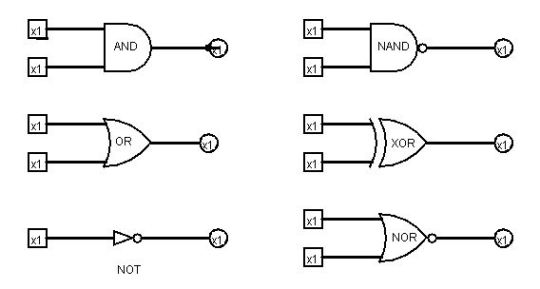
Logic gate symbols
(continued from here)
Before we can hope to comprehend Taoist arithmetic and geometry we need to take a short detour through Boolean logic. First and foremost, we need to see how Boolean logic[1] relates to Cartesian coordinates. That will provide what may be the best foundation available for understanding the Taoist approach to mapping of spacetime and the methodology which mandalic geometry derived from it.[2]
For Descartes, his coordinate system is one thing, his coordinate geometry another. For Taoism, the coordinate system is the geometry.[3] Boolean logic helps to explain how the two perspectives are similar, how different. Cartesian coordinates are static and passive. Taoist coordinates and the derivative mandalic coordinates are active and dynamic. In brief, the latter are changeable and self-changeable, a feat carried out by means of a brand of Boolean logic intrinsic to the system. Although it is true that Descartes’ coordinates do encode much the same information, that is not where their focus of interest lies. Accordingly they turn our own attention elsewhere and we overlook those inherent possibilities.[4]
Descartes’ geometric system is one based on vectors, that is, on both magnitude and direction. But in the scheme of things, the former has somehow eclipsed the preeminence of the latter in the Western hive mind. The opposite is true of Taoist thought and of mandalic geometry. Direction is uniformly revered as primary and prepotent. Magnitude, or scale, is viewed as secondary and subordinate. This mindset allows the Boolean nuances inherent in the system to come to the fore, where they are more easily recognized and deployed.
From such small and seemingly insignificant differences ensue entirely disparate worldviews.
(continuedhere)
Notes
[1] George Boole’s monumental contribution to symbolic logic was published in 1854 but was viewed as only an interesting academic novelty until the second decade of the twentieth century, when it was at last exhumed as a mathematical masterpiece by Whitehead and Russell in their Principia Mathematica.
[2] In Boolean logic (Boolean algebra) logical propositions are represented by algebraic equations in which multiplication and addition (and negation) are replaced with ‘and’ and 'or’ (and 'not’), and where the numbers '0’ and '1’ represent 'false’ and 'true’ respectively. Boolean logic has played a significant role in the development of computer programming and continues to do so.
[3] This is true also of mandalic geometry in its current formulation.
[4] This might be a proper place to proclaim that nature has little use for Descartes’ breed of coordinates, finding them far too stagnant and limiting for her purposes. Fortuitously, she devised her own choice coordinate stock long before Descartes thought to invent his.
© 2015 Martin Hauser
Please note: The content and/or format of this post may not be in finalized form. Reblog as a TEXT post will contain this caveat alerting readers to refer to the current version in the source blog. A LINK post will itself do the same. :)
Scroll to bottom for links to Previous / Next pages (if existent). This blog builds on what came before so the best way to follow it is chronologically. Tumblr doesn’t make that easy to do. Since the most recent page is reckoned as Page 1 the number of the actual Page 1 continually changes as new posts are added. To determine the number currently needed to locate Page 1 go to the most recent post which is here. The current total number of pages in the blog will be found at the bottom. The true Page 1 can be reached by changing the web address mandalicgeometry.tumblr.com to mandalicgeometry.tumblr.com/page/x, exchanging my current page number for x and entering. To find a different true page(p) subtract p from x+1 to get the number(n) to use. Place n in the URL instead of x (mandalicgeometry.tumblr.com/page/n) where
n = x + 1 - p. :)
-Page 293-
Quantum Naughts and Crosses Revisited - IV
The Cube Sliced and Diced
Cartesian Series: Section FHE


(continued from here)
Below we have the second of three frontal sections through the 3-cube, labeled with the Cartesian coordinates of each point. This “slice” is through a plane that lies between an identity face, which contains the trigram HEAVEN, and an inversion face with the trigram EARTH. As such it does not belong fully to either the one or the other, but it shares some characteristics of both. It is a plane, then, of mediation. Again we see here nine Cartesian ordered triads. Due to an artifact of the “slicing” procedure, the four edge centers deceptively appear as though vertices, and the four face centers could be taken as edge centers. Make note that these appearances are illusory. At the center of this section we have the origin point of the cube, Cartesian (0,0,0).[1]
The key to labeling of points in this section[2] and all those to follow can be found here.
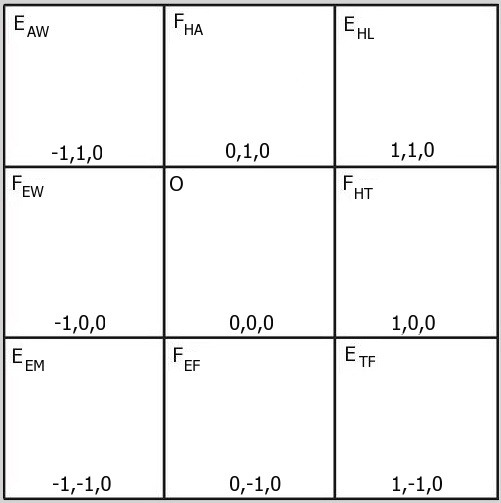
Section FHE
(continuedhere)
Notes
[1] It might be well to note here that the origin point of the coordinate system never appears in either an identity plane or an inversion plane of any of the three section types. All of the planes in which it appears are mediation planes of three dimensions in the case of the Cartesian 3-cube, or of six dimensions in the case of the hybrid mandalic 6D/3D hypercube. This is likely the rationale for why in the I Ching a change involving passage through this central point is referred to as "crossing the Great Water.“ There must be more than coincidence in the fact that Western thought refers to this point as the "origin” and Taoist thought views it as the source and beginning of all things. It’s not that something important was lost in translation. The two notions arose independently, from two very different worldviews. Somehow in the scheme of things, the West came to equate “origin” with "zero" whereas the East came to equate "origin" with “the beginning and end of all things.” Taoism, in particular, sees in this a focus of both creation and dissolution. As we shall soon enough discover, this alternative perspective leads to a different species of arithmetic, one of great antiquity though long lost in the sands of time. Mandalic geometry has unearthed it and will reveal it here, in this blog, for the first time in millennia. As a teaser, it involves a different treatment of what the West calls “zero”. It is an arithmetic more in line with Boolean logic.
[2] The 2-dimensional version of this section is obtained from the x and y coordinates, which by convention are the first and second, respectively, in the Cartesian ordered triads seen here. So the only difference between this section and the FHsectionpreviously viewed is the fact that the z-coordinates here are all zero (0) instead of +1. In our next section, FE, the x and y coordinates will again be as seen here but all z-coordinates will be -1. I believe I detect a trend developing here.
© 2015 Martin Hauser
Please note: The content and/or format of this post may not be in finalized form. Reblog as a TEXT post will contain this caveat alerting readers to refer to the current version in the source blog. A LINK post will itself do the same. :)
Scroll to bottom for links to Previous / Next pages (if existent). This blog builds on what came before so the best way to follow it is chronologically. Tumblr doesn’t make that easy to do. Since the most recent page is reckoned as Page 1 the number of the actual Page 1 continually changes as new posts are added. To determine the number currently needed to locate Page 1 go to the most recent post which is here. The current total number of pages in the blog will be found at the bottom. The true Page 1 can be reached by changing the web address mandalicgeometry.tumblr.com to mandalicgeometry.tumblr.com/page/x, exchanging my current page number for x and entering. To find a different true page(p) subtract p from x+1 to get the number(n) to use. Place n in the URL instead of x (mandalicgeometry.tumblr.com/page/n) where
n = x + 1 - p. :)
-Page 289-
Quantum Naughts and Crosses Revisited - II


(continued from here)
This post builds on orientational material offered in the previous post. An explanation of the procedural method of graphic demonstration used in this post and those following can be found there, and it would be helpful to review that earlier post, if not already done, before proceeding further.
Due in part to the challenging subject matter, in part to arduous graphic demonstration, we’ll approach this investigation in three stages of progressive difficulty. In the first stage we’ll just dangle our feet in the water by looking at how the "slicing methodology" works with ordinary three-dimensional Cartesian coordinates. In the second stage, we’ll go waist-deep, and consider the same Cartesian coordinates in their Taoist notation transliteration equivalents. And in the final stage, we’ll go for full immersion, with graphic representation of true mandalic geometry, that is, plotting all 64 hexagrams in a hybrid 6D/3D coordinate system using the methodology of composite dimension which, of course, has no analogue in purely Cartesian terms.
At each stage - Cartesian, Taoist transliteration, and mandalic - we’ll look at the respective cube in frontal,transverse, and sagittal slices, always in that order and always progressing from identity face containing Cartesian (1,1,1), trigram HEAVEN, or hexagram HEAVEN to inversion face, containing Cartesian (-1,-1,-1), trigram EARTH, or hexagram Earth, as the case may be.
To accomplish our purpose we will require an effective, consistent way to refer to the individual “slices” and each of the 27 Cartesian points. There are three “slices” for each type of sectioning of the “cube”, so a total of nine. I propose that we uniquely identify each “slice” by labeling it with the first letter of the section type (frontal, transverse, or sagittal) and the subscript letters “H” for planes containing trigram or hexagram HEAVEN but not Earth, “E” for planes containing trigram or hexagram EARTH but not HEAVEN, and “HE” for planes containing both trigram forms.[1]
The labels of the sections, then, will be:
- FH frontal section containing HEAVEN but not EARTH
- FHE frontal section containing both HEAVEN and EARTH
- FE frontal section containing EARTH but not HEAVEN
- TH transverse section containing HEAVEN but not EARTH
- THE transverse section containing both HEAVEN and EARTH
- TE transverse section containing EARTH but not HEAVEN
- SH sagittal section containing HEAVEN but not EARTH
- SHE sagittal section containing both HEAVEN and EARTH
- SE sagittal section containing EARTH but not HEAVEN
For the 27 individual discretized Cartesian points, I propose the following labeling convention:
Each point is to be first identified as to type. There are four point types: vertex(V), edge center(E), face center(F), and cube center(O). The cube center corresponds to the Cartesian triad (0,0,0), the origin point of the Cartesian coordinate system. In the Cartesian/Euclidean cube there are 8 vertices, 12 edge centers, 6 face centers, and a single cube center. The higher dimensional mandalic cube has many more of each of these.
Vertices
Having identified the point type, each point is then further identified by a subscript consisting of the first letter of the name of trigram or hexagram that is resident at the point. The single exception to this will be WATER. To differentiate between WATER and WIND, I propose using the letter “A” (first letter of “aqua”, Latin for “water”) to specify WATER. This plan allows us, then, to discriminate among the various vertex points, and also to distinguish them from the other point types. Accordingly, we arrive at these labels for the 8 vertex points:
- VH HEAVEN
- VE EARTH
- VT THUNDER
- VW WIND
- VA WATER
- VF FIRE
- VM MOUNTAIN
- VL LAKE
Edge centers
Edge centers will be labeled “E” along with a subscript consisting of the first letter of its two vertices, “A” being used instead of “W” for WATER. Though this may initially seem excessively complicated, the reasons for setting things up this way will soon be made clear, and it will all become second nature. The 12 edge centers will be labeled as below:
- EHW
- EHF
- EHL
- EET
- EEA
- EEM
- ETF
- ETL
- EAW
- EAL
- EMW
- EMF
Face centers
There are six face centers. Three occur in identity faces of the cube that contain the trigram or hexagram HEAVEN; three, in inversion faces that contain the trigram or hexagram EARTH. Labeling will be with the letter “F” and a subscript consisting of either “E” for EARTH along with one of its companion diagonal vertices, “W” for WIND, “F”, FIRE, “L”, LAKE or “H” for HEAVEN, along with one of its companion diagonal vertices, “T” for THUNDER, “A”, WATER, “M”, MOUNTAIN. So these six face center labels are:
- FEW
- FEF
- FEL
- FHT
- FHA
- FHM
Cube center
The cube center, which is singular in Cartesian terms but a multiple composite in terms of mandalic geometry, will be labeled as:
- O
identifying it as the origin of the coordinate system, that is to say, of both the Cartesian coordinate system and the mandalic coordinate system.
With that, let the games begin!
(continuedhere)
Notes
[1] There are no sections among those described that include both the hexagram HEAVEN and the hexagram EARTH.
© 2015 Martin Hauser
Please note: The content and/or format of this post may not be in finalized form. Reblog as a TEXT post will contain this caveat alerting readers to refer to the current version in the source blog. A LINK post will itself do the same. :)
Scroll to bottom for links to Previous / Next pages (if existent). This blog builds on what came before so the best way to follow it is chronologically. Tumblr doesn’t make that easy to do. Since the most recent page is reckoned as Page 1 the number of the actual Page 1 continually changes as new posts are added. To determine the number currently needed to locate Page 1 go to the most recent post which is here. The current total number of pages in the blog will be found at the bottom. The true Page 1 can be reached by changing the web address mandalicgeometry.tumblr.com to mandalicgeometry.tumblr.com/page/x, exchanging my current page number for x and entering. To find a different true page(p) subtract p from x+1 to get the number(n) to use. Place n in the URL instead of x (mandalicgeometry.tumblr.com/page/n) where
n = x + 1 - p. :)
-Page 287-
Quantum Naughts and Crosses Revisited - I

(continued from here)
Because nature is ever playful, grokking mandalic geometry is much like a game. We view it as a largely serious one, though, one that involves combinatorics, Boolean logic, and magic squares and cubes. Groundwork for what appears in this post, and several to follow, was laid in May, 2014 in a series titled “Quantum Naughts and Crosses” which began here.
The game is played on a board or field made of three-dimensional coordinates of the Cartesian variety upon which are superimposed the six additional extraordinary dimensions unique to mandalic coordinates. For convenience and ease of representation, the board will be displayed here in two dimensional sections abstracted from the Cartesian cube and from the superimposed mandalic hypercube in a manner analogous to the way computed tomography renders sections of the human body.
The sections commonly used[1] in computed tomographyandmagnetic resonance imaging (MRI) are
- Frontal
- Transverse
- Sagittal
For our purposes here, these can be thought of as
- Planes perpendicular to the z-axis viewed from front to back of cube
- Planes perpendicular to the y-axis viewed from top to bottom of cube
- Planes perpendicular to the x-axis viewed from side right to left of cube
These “cuts” will produce square sections through xy-, xz-, and yz-planes, respectively, of the Cartesian cube and, in the case of the mandalic cube, analogous sections of higher dimension.
These choices of sections are made largely for convenience and ease of communicability. They are mainly of a conventional nature.[2] On the other hand, there is special significance in the fact that all three section types progress from identity faces of the cube, containing the trigram or hexagram HEAVEN, to inversion faces, containing trigram or hexagram EARTH. Some manner of consistency of this sort is necessary. The one chosen here will make things easier as we progress.
Ourgameboard has 27 discretized Cartesian points, centered in 3 amplitude levels about the Cartesian origin (0,0,0).[3] Each point in the figure on the right above is represented by a single small cube, but in the two-dimensional sections we’ll be using for elaboration, they will appear as small squares. So the gameboard is “composed of” 27 cubes arranged in a 3x3x3 pattern. But in descriptions of sections, we will view 9 squares in a 3x3 pattern. This configuration will appear as

But keep in mind each small square in this figure is actually a small cube representing one of the 27 discretized Cartesian points we’ve described.
Until next time, then.
(continuedhere)
Notes
[1] The origin of the word "tomography" is from the Greek word “tomos” meaning “slice” or “section” and “graphe” meaning “drawing.” A CT imaging system produces cross-sectional images or “slices” of anatomy, like the slices in a loaf of bread. The “slices” made are transverse (cross-sections from head to toes or, more often, a portion thereof), but reconstructions of the other types of sections described above are sometimes made, and MRI generates all three types natively.
[2] Admittedly, I’ve chosen the convention here myself and to date it is shared by no one else. Perhaps at some future time it will be a shared convention. One can only hope.
[3] These three discrete amplitude levels of potentiality in the mandalic 9-cube correspond geometrically to face centers, edge centers and vertices of the 3-cube of Cartesian coordinates. They are encoded by the six new potential dimensions interacting with the three ordinary Cartesian dimensions in context of the hybrid 6D/3D mandalic cube. They are a feature of the manner of interaction of all nine temporospatial dimensions acting together in holistic fashion. This should begin to give an idea why there is no Taoist line that can generate a 9-cube in a fashion analogous to the way the Western number line is used to generate the Cartesian / Euclidean 3-cube. The 9-dimensional entity is primeval and a variety of different types of "line" can be derived from it. Similarly, the mandala of the I Ching hexagrams cannot be derived from the logic encoded in any linear structure. An overarching perspective is required to derive first the mandala of hexagrams and then from it, a variety of Taoist line types. Nature may be playful, but it is not nearly as simplistic as our Western science, mathematics, and philosophy would have it.
© 2015 Martin Hauser
Please note: The content and/or format of this post may not be in finalized form. Reblog as a TEXT post will contain this caveat alerting readers to refer to the current version in the source blog. A LINK post will itself do the same. :)
Scroll to bottom for links to Previous / Next pages (if existent). This blog builds on what came before so the best way to follow it is chronologically. Tumblr doesn’t make that easy to do. Since the most recent page is reckoned as Page 1 the number of the actual Page 1 continually changes as new posts are added. To determine the number currently needed to locate Page 1 go to the most recent post which is here. The current total number of pages in the blog will be found at the bottom. The true Page 1 can be reached by changing the web address mandalicgeometry.tumblr.com to mandalicgeometry.tumblr.com/page/x, exchanging my current page number for x and entering. To find a different true page(p) subtract p from x+1 to get the number(n) to use. Place n in the URL instead of x (mandalicgeometry.tumblr.com/page/n) where
n = x + 1 - p. :)
-Page 286-
Beyond Descartes - Part 8:
A Good Convention Gone Bad,
An Opportunity Missed
Composite Dimension and
Amplitudes of Potentiality
Episode 2

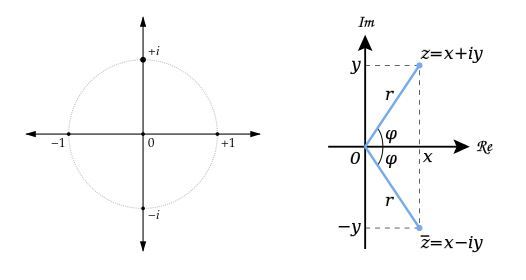
(continued from here)
We cannot blame Descartes for imaginary numbers. It was he, after all, who christened these numbers “imaginary” due to his disdain for them. We can, however, fault him for his lack of insight into how his coordinate system could be extended to create a viable substitute to show that imaginary numbers and the complex plane were nonsensical and make them unnecessary. Alas, that was not to be. Certain powerful forces of history decreed that imaginary numbers were here to stay and we seem stuck with them still, nearly five centuries later.
Not all would agree that imaginary numbers are a bad convention. We should all, however, be able to agree that they are a convention and nothing more. They were invented by humanity.[1] Mathematics may not have taken to them at first - but did eventually welcome them into its fold for better or worse. The real damage was done when physics did the same without first subjecting the mathematical concepts involved to the kind of scrutiny and empirical review it demands of its own theories.
Where is the proof that imaginary numbers and complex plane in fact apply to the real world and particularly to the subatomic realm? It is lacking in the main, and though the geometric concepts have indeed been successfully applied to a number of branches of physics and explanations of a variety of physical phenomena, the reconciliation is incomplete, the fit an uncomfortable one, and too many mysteries remain unexplained.
The term imaginary unit refers to a solution to the equation x2 = -1. By convention, the solution is usually denoted i. As no real number exists with this property, the imaginary number i extends the real numbers and creates an entirely new and different category of numbers. And crucially, at this point an assumption is made, a rather sweeping assumption. It is assumed that the properties of addition and multiplication we’re familiar with - (closure, associativity, commutativity and distributivity) - continue to hold true for this new species of number, or I should say, for this newly derived artificial species of number. That may fly in the ivory tower[2] of pure mathematics, but it lacks the wings and propelling force required to maneuver effectively in the real world that physics investigates. Still, the complex plane, generated by mathematically motivated minds, was soon adopted by physicists the world over.[3]
Mandalic geometry offers an alternative solution in the effective combination of dimensional numbers, composite dimension, and plane of potentiality. We’ll take a close look at potential numbers first. Let’s see how they stack up against the imaginary numbers, how and where they differ. Distinctions between complex plane and potential plane are subtle but they make for a world - a universe, actually - of difference. When next we meet, kindly check all preconceptions at the door. Entirely untrodden paths await.
(continuedhere)
Image: (lower left) Imaginary unit i in the complex or Cartesian plane. Real numbers lie on horizontal axis, imaginary numbers on the vertical axis. By Loadmaster (David R. Tribble), (Own work) [CC BY-SA 3.0orGFDL], via Wikimedia Commons; (lower right) A diagram of the complex plane. The imaginary numbers are on the vertical axis, the real numbers on the horizontal axis. By Oleg Alexandrov [GFDLorCC-BY-SA-3.0],via Wikimedia Commons
Notes
[1] Let those who suppose differently, who believe them to be an indelible part of nature itself, prove their case. Until they do, I will see fit to call such numbers manmade inventions.
[2] I use the term ivory tower without malice of any kind in this context, rather judiciously, because mathematics demands no more than internal consistency for its particular brand of truth. It is not much interested in examining its definitions and axioms to determine how they shape up against hard reality. Mathematicians leave that "sordid work" to physicists and philosophers, both of whom are more willing to dig in the mire of nature, seeking its actual relics. Enthusiastically to persist in such a real world-oblivious manner as pure mathematicians do, I think, requires a very special type of mind, one I don’t fully understand myself.
[3] In some circles this would be considered no less than a monumental leap of faith, particularly in view of the many unproved assumptions made in creation of imaginary and complex numbers. This was, in fact, the New Faith promulgated by Descartes’ contemporaries, the rationalists of the Age of Reason, to supplant the Old Faiths of Religion and Scholasticism.
© 2015 Martin Hauser
Please note: The content and/or format of this post may not be in finalized form. Reblog as a TEXT post will contain this caveat alerting readers to refer to the current version in the source blog. A LINK post will itself do the same. :)
Scroll to bottom for links to Previous / Next pages (if existent). This blog builds on what came before so the best way to follow it is chronologically. Tumblr doesn’t make that easy to do. Since the most recent page is reckoned as Page 1 the number of the actual Page 1 continually changes as new posts are added. To determine the number currently needed to locate Page 1 go to the most recent post which is here. The current total number of pages in the blog will be found at the bottom. The true Page 1 can be reached by changing the web address mandalicgeometry.tumblr.com to mandalicgeometry.tumblr.com/page/x, exchanging my current page number for x and entering. To find a different true page(p) subtract p from x+1 to get the number(n) to use. Place n in the URL instead of x (mandalicgeometry.tumblr.com/page/n) where
n = x + 1 - p. :)
-Page 284-
Beyond Descartes - Part 7
Composite Dimension and
Amplitudes of Potentiality
Episode 1


(continued from here)
Having frightened away all the cognitive wusses with my remark in that last post about the complexity of composite dimension and of the mandalic coordinate system based on it, I have a confession to make to those followers who remain. Although understanding the ideas involved requires a step back and viewing them from a different perspective alien to our Western modes of thought, composite dimension and the plane of potentiality are at once more natural and far less complicated than are imaginary numbers and the complex plane. Stay with me here. There is a light at the end of the tunnel growing ever brighter.
The 6D/3D mandalic cube is a hybrid structure having four levels of amplitude potentiality represented geometrically by 27 3D points which correspond to Cartesian points centered about Cartesian (0,0,0) and 64 6D points, corresponding to the 64 hexagrams, similarly centered and distributed among the 27 Cartesian points in such a way as to create a probability distribution through all three Cartesian dimensions, that is with geometric progression of the number of hexagrams resident in the different amplitudes or orbitals. This gives rise to the mandalic form of the coordinate system. There are four well-defined orbitals or shells in this unique geometric arrangement of hexagrams and, parenthetically, whatever it is they represent in physical terms.[1]
We can conceptually abstract and decompose the 3D moiety of this concept entity, the part corresponding to Cartesian space. In doing so we identify a cube having a single center and eight vertices, all points by Euclidean/Cartesian reckoning, twelve edges (lines), each having an edge center (points), and six faces (planes), each having a center (point) equidistant from its four vertices. Each vertex point is shared equally by three faces or planes of the cube and each edge, by two adjacent faces or planes. We have previously analyzed in detail how the six planes of the 3D cube dovetail with one another and the repercussions involved. (See hereandhere.) One of the most important consequences we find is that each face center coordinates in a special way all four vertices of the face. This becomes particularly significant in consideration of the composite dimension-derived hypercube faces of mandalic geometry.
The 6D moiety follows an analogous but more complex plan and has been formulated so as to be commensurate with the convention of the Cartesian coordinate system. It also introduces measurement of a discretized time to the coordinates, thus rendering the geometry one of spacetime. The hybrid 6D/3D configuration introduces probability as well through its bell curve/normal distribution (1, 2) of hexagrams; and also, the two new directions, manifestation (differentiation) and potentialization (dedifferentiation).[2] These unfamiliar directions are unique to mandalic geometry and the I Ching upon which it is based.
In the lower diagram above, the figure on the right represents the skeletal structure of the hybrid 6D/3D coordinate system; the figure on the left, the skeletal structure of the corresponding 3D Cartesian moiety. The 27 discretized points of the cube on the left have become 64 points of the 6D hypercube on the right. In the next post we will begin to flesh these two skeletons out.[3] The end results are nothing short of amazing.
(continuedhere)
Notes
[1] With this remark I am avowing that mandalic geometry is intended not just as an abstract pure mathematical formulation, but rather as a logical/geometrical mapping of energetic relationships that exist at some scale of subatomic physics, Planck scale or other. I maintain the possibility that this is so despite the obvious and unfortunate truth that we cannot now ascertain just what it is the hexagrams represent, and may, in fact, never be able to.
[2] Manifestation/differentiation corresponds to the direction of divergence; potentialization/dedifferentiation, to the direction of convergence. The former is motion away from a center; the latter, motion toward a center. Convergenceanddivergence are the two directions found in every Taoist line that do not occur in Cartesian space, at least not explicitly as such. There are functions in Cartesian geometry that converge toward zero as a limit. To reach zero in Cartesian space however is to become ineffective. That is quite different from gaining increased potential, potential which can then be used subsequently in new differentiations. (See also the series of posts beginning here.) Both the terms differentiationanddedifferentiation were brazenly borrowed from the field of biology, while the designations manifestandunmanifest have been shamelessly appropriated from Kantian philosophy, though similar concepts also occur in different terminology in deBroglie-Bohmian pilot-wave theoryasexplicitandimplicit.
[3] In the figure of the cube on the lower left above there is a single Cartesian triad (point) identifying each vertex (V), edge center (E), face center (F), and cube center C. In the right figure, the hybrid 6D/3D hypercube at each vertex has one resident hexagram identifying it, two resident hexagrams at each edge center, four resident hexagrams identifying each face center, and eight resident hexagrams identifying the hypercube center. This brings the total of hexagrams to 64, the number found in the I Ching and the total possible number (26 = 64). This geometric progression of hexagram distribution, through three Cartesian dimensions constitutes the mandalic form. It is entirely the result of composite dimension.
© 2015 Martin Hauser
Please note: The content and/or format of this post may not be in finalized form. Reblog as a TEXT post will contain this caveat alerting readers to refer to the current version in the source blog. A LINK post will itself do the same. :)
Scroll to bottom for links to Previous / Next pages (if existent). This blog builds on what came before so the best way to follow it is chronologically. Tumblr doesn’t make that easy to do. Since the most recent page is reckoned as Page 1 the number of the actual Page 1 continually changes as new posts are added. To determine the number currently needed to locate Page 1 go to the most recent post which is here. The current total number of pages in the blog will be found at the bottom. The true Page 1 can be reached by changing the web address mandalicgeometry.tumblr.com to mandalicgeometry.tumblr.com/page/x, exchanging my current page number for x and entering. To find a different true page(p) subtract p from x+1 to get the number(n) to use. Place n in the URL instead of x (mandalicgeometry.tumblr.com/page/n) where
n = x + 1 - p. :)
-Page 283-
Beyond Descartes - Part 6
The Fiction Formerly Known As the Line


(continued from here)
Rereading the last post a moment ago I see I fell into the same old trap, namely describing a concept arising from an alternative worldview in terms of our Western worldview. It is so astonishingly easy to do this. So it is important always to be on guard against this error of mind.
In saying that the Taoist number line is the basis of its coordinate system I was phrasing the subject in Western terminology, which doesn’t just do an injustice to the truth of the matter, it does violence to it, in the process destroying the reality: that within Taoism, the coordinate system is primary. It precedes the line, which follows from it. What may be the most important difference between the Taoist apprehension of space and that of Descartes lies encoded within that single thought.
Descartes continues the fiction fomented in the Western mind by Euclid that the point and the line have independent reality. Taking that to be true, Descartes constructs his coordinate system using pointsandlines as the elemental building blocks. But to be true to the content and spirit of Taoism, this fabrication must be surrendered. For Taoism, the coordinate system, which models space, or spacetime rather, is primary. Therefore to understand the fictional Taoist line we must begin there, in the holism and the complexity of its coordinate system where dimension, whatever it may be, reigns supreme.[1]
And that means we can no longer disregard composite dimension, postponing discussion of it for a later time, because it is the logical basis on which the I Ching is predicated. It is related to what we today know as combinatorics,Boolean algebra, and probability, and is what gives rise to what I have called the plane of potentiality. It is the very pith of mandalic geometry, what makes it a representation of mandalic spacetime.[2]
(continuedhere)
Notes
[1] In my mind, dimension is a category of physical energetic description before it is a category of geometrical description. When particle physicists speak about “quantum numbers” I think they are actually, whether intended or not, referring to dimensions. If this is true, then our geometries should be constructed to reflect that primordial reality, not arbitrarily as we choose.
[2] In speaking of logic and the I Ching in the same breath I am using the term in its broadest sense as any formal system in which are defined axioms and rules of inference. In reference to the I Ching, the logic involved is far removed from the rationalism bequeathed to Descartes by his times. It is a pre-rationalist logic that prevailed in human history for a very long time before the eventual splitting off of the irrational from the rational. This means also that the I Ching is among other things a viable instrument to access strata of human minds long dormant in historical times, other than possibly, at times, in poetry and art and the work of those select scientists who make extensive use of intuition in the development of their theories.
Note to self: Two contrasting systems of thought based on very different worldviews can never be adequately explained in terms of one another. At times though, for lack of anything better, we necessarily fall back on just such a strategy, however limited, and make the best of it we can.
© 2015 Martin Hauser
Please note: The content and/or format of this post may not be in finalized form. Reblog as a TEXT post will contain this caveat alerting readers to refer to the current version in the source blog. A LINK post will itself do the same. :)
Scroll to bottom for links to Previous / Next pages (if existent). This blog builds on what came before so the best way to follow it is chronologically. Tumblr doesn’t make that easy to do. Since the most recent page is reckoned as Page 1 the number of the actual Page 1 continually changes as new posts are added. To determine the number currently needed to locate Page 1 go to the most recent post which is here. The current total number of pages in the blog will be found at the bottom. The true Page 1 can be reached by changing the web address mandalicgeometry.tumblr.com to mandalicgeometry.tumblr.com/page/x, exchanging my current page number for x and entering. To find a different true page(p) subtract p from x+1 to get the number(n) to use. Place n in the URL instead of x (mandalicgeometry.tumblr.com/page/n) where
n = x + 1 - p. :)
-Page 282-
Beyond Descartes - Part 5
Reciprocation, Alternation, Decussation
Imaginary and Complex Numbers

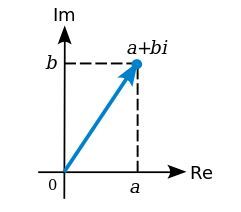
(continued from here)
Previously in this blog a number of attempts have been made to explicate the Taoist number line and contrast it with the Western version of the same. It is essential to do this and to do it flawlessly, first because different systems of arithmetic result from the two, and secondly because the mandalic coordinate system is based on the former perspective while the Cartesian coordinate system is based on the latter.[1]
What has been offered earlier has been accurate to a degree, a good first approximation. Here we intend to present a more definitive account of the Taoist number line, describing both how it is similar to and how it differs from the Western number line used by Descartes in formation of his coordinate system. This will inevitably transport us well beyond that comfort zone offered by the more accessible three-dimensional cubic box that has heretofore engaged us.
Both Taoist and Western number lines observe directional locative division of their single dimension into two major partitions: positive and negative for the West; yinandyang for Taoism.[2] There the similarities essentially end. From its earliest beginnings Taoism recognized a second directional divisioning in its number line, that of manifest/unmanifestorbeingandbecoming.[3] The West never did such. As a result, some time later the West found it necessary to invent imaginary numbers.[4][5]
Animaginary number is a complex number that can be written as a real numbermultiplied by theimaginary uniti, which is defined by its property i2 = −1. [Wikipedia]
Descartes knew of these numbers but was not particularly fond of them. It was he, in fact, who first used the term “imaginary” describing them in a derogatory sense. [Wikipedia] The term “imaginary number” now just denotes a complex number with a real part equal to 0, that is, a number of the form bi. A complex number where the real part is other than 0 is represented by the form a + bi.
In place of the complex plane, Taoism has (and always has had from time immemorial) a plane of potentiality. An explanation of this alternative plane was attempted earlier in this blog, but it can likely be improved. This post has simply been a broad brushstrokes overview. In the following posts we will look more closely at the specifics involved.[6]
(continuedhere)
Image (lower): A complex number can be visually represented as a pair of numbers (a, b) forming a vector on a diagram representing the complex plane. “Re” is the real axis, “Im” is the imaginary axis, and i is the imaginary unit which satisfies i2 = −1. Wolfkeeper at English Wikipedia [GFDL (http://www.gnu.org/copyleft/fdl.html) or CC BY-SA 3.0 (http://creativecommons.org/licenses/by-sa/3.0)], via Wikimedia Commons
Notes
[1] The arithmetic system derived from the Taoist number line can perhaps best be understood as a noumenal one. It applies to the world of ideas rather than to our phenomenal world of the physical senses, but it may also apply to the real world, that is, the real real world which we can never fully access.
Much of modern philosophy has generally been skeptical of the possibility of knowledge independent of the physical senses, and Immanuel Kant gave this point of view its canonical expression: that the noumenal world may exist, but it is completely unknowable to humans. In Kantian philosophy, the unknowable noumenon is often linked to the unknowable “thing-in-itself” (Ding an sich, which could also be rendered as “thing as such” or “thing per se”), although how to characterize the nature of the relationship is a question yet open to some controversy. [Wikipedia]
[2] From the perspective of physics this involves a division into two major quanta of charge, negative and positive, which like yinandyang can be either complementary or opposing. Like forces repel one another and unlike attract. This is the basis of electromagnetism, one of four forces of nature recognized by modern physics. But it is likely also the basis, though not fully recognized as such, of the strong and weak nuclear forces, possibly of the force of gravity as well. I would suspect that to be the case. The significant differences among the forces (or force fields, the term physics now prefers to use) lie mainly, as we shall see, in intricate twistings and turnings through various dimensions or directions that negative and positive charges undergo in particle interactions.
[3] It is this additional axis of probabilistic directional location, along with composite dimensioning, both of which are unique to mandalic geometry, that make it a geometry of spacetime, in contrast to Descartes’ geometry which, in and of itself, is one of space alone. The inherent spatiotemporal dynamism that is characteristic of mandalic coordinates makes them altogether more relevant for descriptions of particle interactions than Cartesian coordinates, which often demand complicated external mathematical mechanisms to sufficiently enliven them to play even a partial descriptive role, however inadequate.
[4] In addition to their use in mathematics, complex numbers, once thought to be "fictitious" and useless, have found practical applications in many fields, including chemistry, biology, electrical engineering, statistics, economics, and, most importantly perhaps, physics..
[5] The Italian mathematician Gerolamo Cardano is the first known to have introduced complex numbers. He called them “fictitious” during his attempts to find solutions to cubic equations in the 16th century. At the time, such numbers were poorly understood, consequently regarded by many as fictitious or useless as negative numbers and zero once were. Many other mathematicians were slow to adopt use of imaginary numbers, including Descartes, who referred to them in his La Géométrie, in which he introduced the term imaginary, that was intended to be derogatory. Imaginary numbers were not widely accepted until the work of Leonhard Euler (1707–1783) and Carl Friedrich Gauss (1777–1855). Geometric interpretation of complex numbers as points in a complex plane was first stated by mathematician and cartographer Caspar Wessel in 1799. [Wikipedia]
[6] What I have called here the plane of potentiality occurs only implicitly in the Taoist I Ching but is fully developed in mandalic geometry. It may be related to bicomplex numbers or tessarines in abstract algebra, the existence of which I only just discovered. Unlike the quaternions first described by Hamilton in 1843, which extended the complex plane to three dimensions, but unfortunately are not commutative, tesserines or bicomplex numbers are hypercomplex numbers in a commutative, associative algebra over real numbers, with two imaginary units (designated i and k). Reading further, I find the following fascinating remark,
The tessarines are now best known for their subalgebra of real tessarines t = w + y j, also called split-complex numbers, which express the parametrization of the unit hyperbola. [Wikipedia]
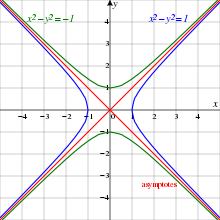
The rectangular hyperbola x2-y2 and its conjugate, having the same asymptotes. The Unit Hyperbola is blue, its conjugate is green, and the asymptotes are red. By Own work (Based on File:Drini-conjugatehyperbolas.png) [CC BY-SA 2.5],via Wikimedia Commons
Note to self: Also investigate Cayley–Dickson constructionandzero divisor. Remember, this is a work still in progress, and if a bona fide mathematician believes division by zero is possible in some circumstances, (as is avowed by mandalic geometry), I want to find out more about it.
© 2015 Martin Hauser
Please note: The content and/or format of this post may not be in finalized form. Reblog as a TEXT post will contain this caveat alerting readers to refer to the current version in the source blog. A LINK post will itself do the same. :)
Scroll to bottom for links to Previous / Next pages (if existent). This blog builds on what came before so the best way to follow it is chronologically. Tumblr doesn’t make that easy to do. Since the most recent page is reckoned as Page 1 the number of the actual Page 1 continually changes as new posts are added. To determine the number currently needed to locate Page 1 go to the most recent post which is here. The current total number of pages in the blog will be found at the bottom. The true Page 1 can be reached by changing the web address mandalicgeometry.tumblr.com to mandalicgeometry.tumblr.com/page/x, exchanging my current page number for x and entering. To find a different true page(p) subtract p from x+1 to get the number(n) to use. Place n in the URL instead of x (mandalicgeometry.tumblr.com/page/n) where
n = x + 1 - p. :)
-Page 281-
Beyond Descartes - Part 4
Directional Locatives


(continued from here)
Descartes derives his directional locatives from considerations of human anatomy, as does most of Western culture. The descriptive terms generally used for orientation purposes include left/right;up/down; and forward/backward.[1] The first two sets have been extended also to refer to the cardinal directions, North/South and East/West.
To the degree that they conform to Cartesian coordinates, mandalic coordinates adhere to this schema as well. However, mandalic geometry and the Taoist I Ching upon which it is largely based constitute a system of combinatorial relationships that is rooted mainly in radial symmetry rather than bilateral symmetry. For mandalic coordinates, the principal directional locatives can be characterized as divergentandconvergent, and the principal movements or changes in position, as centrifugalandcentripetal.[2]
One of the important consequences of this alternative geometric perspective is that the frame of reference as well as the complex pattern produced are more integrative than in the method of Descartes. Looked at another way, Descartes is most enamored by specification of location of individual points whereas mandalic geometry is more concerned with relationships of parts - and the overall unification of the entire complex holistic system.[3]
From this one seemingly small difference an enormous disparity grows in a manner reminiscent of chaos theory.[4] Cartesian coordinates and mandalic coordinates can be made commensurate, but remain after all two exclusive systems of spatial awareness, leading to very disparate results arising out of what seem small initial differences.[5]
(continuedhere)
Image (bottom): Animation of a double compound pendulum showing chaotic behaviour. By Catslash (Own work). [Public domain], via Wikimedia Commons.[6]
Notes
[1] Such terminology is of little use, despite its biological origins, to an amoeba or octopus, not to mention those extraterrestrials who have been blessed with a second set of eyes at the back of their heads. (We wuz cheated.)
[2] To be more correct, the radial symmetry involved is of a special type. It is not simple planar radial symmetry, nor even the three-dimensional symmetry of a cube and its circumscribed and inscribed spheres. It is all of those but also the symmetry involved in all the different faces of a six-dimensional hypercube and the many relationships among them.
[3] To be fair, Descartes eventually gets around to relating his points in a systematic whole we now know as analytic geometry (1,2). But as great an achievement though it might be, Cartesian geometry lacks the overarching cosmographical implications which characterize mandalic geometry and the I Ching. Descartes’ system is purposed differently, arising as it does out of a very different world view. To paraphrase George Orwell,
“All geometries are sacred, but some geometries are more sacred than others.”
[4] Chaos theory was summarizedbyEdward Lorenzas:
“When the present determines the future, but the approximate present does not approximately determine the future.”
[5] An example of one unique result of mandalic coordination of space is the generation of a geometric/logical probability wave of all combinatorial elements that occur in the 6D/3D hybrid composite dimension specification of the system. I envision this as offering a possible model at least, if not an actual explanation, of the probabilistic nature of quantum mechanics. Extrapolating this thought to its uttermost conclusion, it is not entirely inconceivable, to my mind at least, that probability itself might be the result of composite dimensioning. (And for such a brash remark I would almost surely be excommunicated from the fold were I but a member.)
[6] Starting the pendulum from a slightly different initial condition would result in a completely different trajectory. The double rod pendulum is one of the simplest dynamical systems that has chaotic solutions. [Wikipedia]
© 2015 Martin Hauser
Please note: The content and/or format of this post may not be in finalized form. Reblog as a TEXT post will contain this caveat alerting readers to refer to the current version in the source blog. A LINK post will itself do the same. :)
Scroll to bottom for links to Previous / Next pages (if existent). This blog builds on what came before so the best way to follow it is chronologically. Tumblr doesn’t make that easy to do. Since the most recent page is reckoned as Page 1 the number of the actual Page 1 continually changes as new posts are added. To determine the number currently needed to locate Page 1 go to the most recent post which is here. The current total number of pages in the blog will be found at the bottom. The true Page 1 can be reached by changing the web address mandalicgeometry.tumblr.com to mandalicgeometry.tumblr.com/page/x, exchanging my current page number for x and entering. To find a different true page(p) subtract p from x+1 to get the number(n) to use. Place n in the URL instead of x (mandalicgeometry.tumblr.com/page/n) where
n = x + 1 - p. :)
-Page 280-
Beyond Descartes - Part 3
Logic Gates and Switches: Introduction

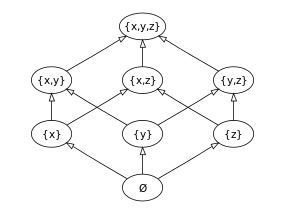
(continued from here)
It has been often noted throughout this work that mandalic geometry does not view points as fundamental geometrical elements in the manner Descartes and Euclid do. It considers them to be evanescent communions of two or more dimensions. This alternative perspective conveys further the insight that such conjoint formative interface locations both separate and connect. They are both boundaries and tipping points between all the participating dimensions, what I have whimsically referred to previously as dimension interchange lanes. This is a far cry from the way Descartes regards and handles hispoints.
Descartes’points are locations, pure and simple, defining occupants of a uniform geometrical space. They don’t really doorattempt anything; they simply are. They do not act, but are acted upon by the equations of Cartesian geometry. The points themselves, for all the reality Descartes attempts to imbue them with, turn out, when the curtain is drawn, to be no more capable of mustering an original thought than is the Scarecrow in L. Frank Baum’s The Wonderful Wizard of Oz. Being of feeble mind themselves, they just sit there awaiting brainy algebra to act upon them. In and of themselves, beyond determining location, they are essentially impotent.[1]
A useful way to apprehendpoint locations of mandalic coordinates is to interpret them as logic gates which can handle transition operations in a variety of different ways depending upon the dimension amplitudes verged on. Passage through such locations is potentially bidirectional, in theory if not always in actuality at a given moment, so they accommodate both convergent and divergent flows throughout varied amplitude levels of the mandalic structure. To wit, they can promote both differentiationandpotentialization phases of an evolving process. Because these points arise through confluence of dimensions, they bear within their transitory being information imparted by the participating dimensions. Contrary to Descartes’ simpleminded points, these points have the capacity to encode an intelligence derived from their parent dimensions.[2]
In electrical engineering,aswitch is an electrical component that can control an electrical circuit by initiating or interrupting the current or by diverting it from one conductor to another. The most usual configuration consists of a manually operated electromechanical device having one or more sets of electrical contacts. These contacts are connected to external circuits. Each set of contacts can be in either of two states: either “closed” meaning the contacts are touching and electricity can flow between them, or “open”, meaning the contacts are separated in which case the switch is nonconducting. The mechanism that brings about the transition between these two states - openorclosed - can be either a “toggle” (flip switch for continuous “on” or “off”) or “momentary” (depress and hold for “on” or “off”) type.
Understand that logic gates don’t apply only to electronic devices nor are they controlled only by such devices. The concepts and methodologies involved go far beyond simple electronics.
Logic gates are primarily implemented using diodes or transistors acting as electronic switches, but can also be constructed using vacuum tubes, electromagnetic relays (relay logic), fluidic logic, pneumatic logic, optics, molecules, or even mechanical elements. With amplification, logic gates can be cascaded in the same way that Boolean functions can be composed, allowing construction of a physical model of all of Boolean logic, and therefore, all of the algorithms and mathematics that can be described with Boolean logic. Wikipedia
For our purposes here and now, we need only mention that scalar numbers and vectors can be implemented in the context of Boolean logic as well. Indeed, the incessant complex cotillion performed by subatomic particles can likely be subjected to such an analysis or one similar.[3] And, of course, also digital circuits and computer architecture.
This has been just an introductory teaser to the topic of logic gates in mandalic geometry. I’m getting my feet wet now myself. This is all still quite new to me so we’ve barely scratched the surface here. An upcoming post will survey the logic gates and switches identifiable among groups of transliteration Cartesian coordinates and mandalic coordinates. This may take a while to materialize, but I think will be worth the wait. And in case I forget to bring up the subject of how fractals fit into all this sometime in the next month or two, remind me please that I intended to.
(continuedhere)
Notes
[1] This could be a mathematician’s beautiful dream, but a physicist’s abhorrent nightmare.
[2] Although this statement pertains especially to composite dimension points, it is true, to a degree, of ordinary three-dimensional points as well when viewed in a manner similar to that using trigram tranliterations of Cartesian triads. This means then that Cartesian coordinates could do the same and to the same degree, if they were handled in the same manner as trigram coordinates are. The point is they are not and presumably never were.
[3] With that last remark I likely committed quantum mechanical heresy. If I in fact did, so be it. If it doesn’t quite hit the intended mark we can refer to it as steampunk mechanics.
Image (lower): Boolean lattice of subsets. KSmrq. Licensed under CC BY-SA 3.0viaCommons.
© 2015 Martin Hauser
Please note: The content and/or format of this post may not be in finalized form. Reblog as a TEXT post will contain this caveat alerting readers to refer to the current version in the source blog. A LINK post will itself do the same. :)
Scroll to bottom for links to Previous / Next pages (if existent). This blog builds on what came before so the best way to follow it is chronologically. Tumblr doesn’t make that easy to do. Since the most recent page is reckoned as Page 1 the number of the actual Page 1 continually changes as new posts are added. To determine the number currently needed to locate Page 1 go to the most recent post which is here. The current total number of pages in the blog will be found at the bottom. The true Page 1 can be reached by changing the web address mandalicgeometry.tumblr.com to mandalicgeometry.tumblr.com/page/x, exchanging my current page number for x and entering. To find a different true page(p) subtract p from x + 1 to get the number(n) to use. Place n in the URL instead of x (mandalicgeometry.tumblr.com/page/n) where
n = x + 1 - p. :)
-Page 279-
Earlier to Later Heaven: Fugue VI Beyond Descartes - Part 1


(continued from here)
In this post we take a short detour within our current central topic, that of relationship of Earlier Heaven and Later Heaven arrangements of the trigrams. The new material included here grew out of ruminations on the aforesaid primary topic though, and is actually not so much a detour as a preparing the way for what I hope will be the eventual solution of our problem at hand.
Mandalic geometry, as we’ve seen, is fully commensurate with the coordinate system of Descartes, but its principal forebears lie elsewhere. It is derived largely from Taoist and pre-Taoist thought structures, most importantly the I Ching, the earliest strata of which were formed before the separation of rational and irrational thought in the history of human cognition. As a result it is capable of far exceeding the possibilities of the Cartesian coordinate system, a product of the Enlightenment and Age of Rationalism. It offers geometry the possibility of a structural fluidity and a functional variability that Cartesian geometry lacks.[1]
From the very beginning of this project I’ve been much puzzled by the lack in traditional Chinese thought of a symbol corresponding to the zero of the Western number line and number theory.[2] Traditional Asian thought does not uniformly lack a zero symbol.[3] And yet the I Ching and Taoism manage well enough without one, electing to base their numerical relationships instead entirely on combinatorics involving permutations of yinandyang – what we in the West call negativeandpositive – through multiple dimensions. It is an entirely different perspective arising out of a very different worldview.[4]
What Taoism invented in the process was a unique, thoroughly self-consistent brilliant system of logic/geometry/combinatorics which has been masquerading, all these many centuries, as “just a method of divination.”[5] In essence, Chinese thought invented a discrete number system and geometry, one based on vectors rather than scalars, a vector geometry that can be extrapolated to any desired number of dimensions. The I Ching settles for just six, the first whole number multiple of three. That is complicated enough.[6][7]
(continuedhere)
Notes
[1] For one example of the advantages such variability and fluidity offer, in this particular case in creating dynamic, phase-shifting forms of nanomaterials, see here.
[2] For a short history of the concept of zeroseeWho Invented Zero?
[3] The West, after all, derived its zero symbol ultimately via India.
[4] One might well speculate whether the significant root difference in world view between traditional Indian and Chinese thought lay in the fact that Indian mathematicians could have created a Zero out of nothingness (Śūnyatā), a key term in Mahayana Buddhism and also some schools of Hindu philosophy while Taoist thought did not include a concept of nothingness. Instead it conceived of a formlessness prior to manifestation. In Taoist cosmology Taiji is a term for the “Supreme Ultimate” state of undifferentiated absolute and infinite potential, the oneness before duality, from which yinandyang originate. So it might be that lacking a concept of nothingness forestalled invention of a zero symbol. Still, it also allowed creation of an original, unique holistic philosophy of reality, found perhaps nowhere else.
[5] The Russian philosopher, mathematician and authorPeter D. Ouspensky (1878-1947) relates an apocryphal legend regarding the origin of the Tarot, the moral of which has significance also to the history of the I Ching.
[6] In its emphasis on vector analysis and primacy of dimension the philosophy which underlies the I Ching and mandalic geometry shares some characteristics of Clifford algebra.
[7] One of the important things with respect to physics I hope to show with mandalic geometry is that it is possible to construct an integrated geometrical / logical system which is self-sufficient and self-consistent, capable of modeling interactions of subatomic particles of the Standard Model and then some. This goal is, I believe, approximated in mandalic geometry by meticulous coupling of the methodologies of composite dimension and trigram toggling, although it quickly becomes apparent that a system based upon what is after all a relatively small number of dimensions - six in the case in point - becomes vastly complex and difficult to follow, at least initially. One can’t help wondering how physics will be able to correlate all the intricate data resulting from its countless particle accelerator collisions and combine it into a consistent whole without some very fancy mental acrobatics on the part of theoretical physicists. Without a suitable logical scaffold that might take an inordinately long time to achieve.
© 2015 Martin Hauser
Please note: The content and/or format of this post may not be in finalized form. Reblog as a TEXT post will contain this caveat alerting readers to refer to the current version in the source blog. A LINK post will itself do the same. :)
Scroll to bottom for links to Previous / Next pages (if existent). This blog builds on what came before so the best way to follow it is chronologically. Tumblr doesn’t make that easy to do. Since the most recent page is reckoned as Page 1 the number of the actual Page 1 continually changes as new posts are added. To determine the number currently needed to locate Page 1 go to the most recent post which is here. The current total number of pages in the blog will be found at the bottom. The true Page 1 can be reached by changing the web address mandalicgeometry.tumblr.com to mandalicgeometry.tumblr.com/page/x, exchanging my current page number for x and entering. To find a different true page(p) subtract p from x + 1 to get the number(n) to use. Place n in the URL instead of x (mandalicgeometry.tumblr.com/page/n) where
n = x + 1 - p. :)
-Page 277-
(Part 1 Here) (Super-long post ahead!)
Talismans/Charms/符箓/符咒


The talismans in both the live-action and animated shows originate from Daoist talismans, which in turn developed from early shamanistic traditions. Like what Lan Wangji tells Jiang Cheng in the show, real life Daoist talismans are usually made for beneficial purposes, one of which being to ward off evil spirits. Other purposes of such talismans include everything from curing illnesses to controlling floods to communicating with the gods. In order to call forth gods to accomplish these goals, writing/drawing on the talismans usually include “incantations” that start with “勅令”, or “command”, on the very top. The word can be traced back to 敕令, which refers to orders from an emperor, but since 敕 is traditionally reserved for the emperor, Daoists use 勅 on their talismans. The meaning is also slightly changed, as 敕 has 攵 on the right, implying the order is written; meanwhile 勅 has 力/force on the right, implying the order is executed by “force”.
The body of the talisman sometimes include complex combinations of Chinese characters (合体字/複文) that are more like visual symbols and do not have their own pronunciations. On a talisman these “combination characters” are usually arranged in a specific pattern. These combination characters aren’t exclusive to Daoism, however. Below is a well-known combination character created from the word 招財進寶 (lit: “gaining wealth and attracting riches”), commonly seen pasted on doors and windows around Chinese New Year for luck.
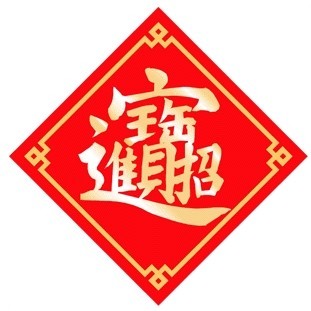
Other elements of a talisman are mostly made up of symbols such as the yinyang symbol, eight trigrams, and special strokes that also hold symbolic meaning.
A fun detail from the animated show: in the scene where Jiang Cheng shows the inverted evil-warding talisman to Lan Wangji, we can see that WWX’s addition in blood near the top turns the 人 part into 夷, as in 夷陵老祖/”Yiling Founder”, giving the viewer a solid hint as to who changed the talismans.

Sword (Jian)/剑

Jian sword refers specifically to pointed double-edged one-handed straight swords. The sword is important to religious Daoism, but its origin as a culturally-significant symbol lies in history.
The sword was an actual weapon used on the battlefield before Han dynasty (before 202 BC), and it was that time, long long ago, that the sword was associated with certain human qualities, such as an unyielding sense of justice. From there, the jian sword eventually became an ornamental item symbolizing high social status. Evidences of this can be found in the Book of Rites (《禮記》), a book detailing etiquettes and rituals for nobles of Zhou dynasty (1046-256 BC). For example, a chapter mentioned “when looking upon a gentleman’s attire, sword, and carriage horse, do not gossip about their value” (“觀君子之衣服,服劍,乘馬,弗賈”). One such decorative jian sword artifact even survived to this day:

Sword of Goujian, King of Yue (越王勾践剑), part of the collection of Hubei Provincial Museum. Note: the engraved “bird-worm seal script” (鳥蟲篆; basically a highly decorative font) text says “Goujian, King of Yue, made this sword for his personal use” (戉王鸠浅,自乍用鐱).
By the Eastern Han dynasty (25-220 AD), Daoism had established itself as a folk religion. Many of the customs and etiquettes passed down from pre-Qin dynasty times were mystified and given religious importance in the then newly-established Daoist belief system, including the aforementioned etiquettes involving the jian sword. People came to believe the jian sword as holding magical properties, a weapon gifted by heaven itself, allowing its wielder (usually a Daoist priest) to fight and triumph over demonic spirits. As the jian sword became more and more of a Daoist ceremonial item than an actual weapon, it also slowly changed to this familiar form today:

(Modern ceremonial Daoist jian swords. Fun fact: it is widely believed that jian swords made entirely of peach wood have better demon-banishing abilities than regular swords, since peach trees were said to have demon-warding effects.)
So, a sword that was worn to show respect, used to showcase social status AND have demon-warding powers? Does that sound familiar?






It was no accident that the day WWX refused to take his sword with him (since he gave his core to Jiang Cheng so Jiang Cheng could continue to use swords) was also the day the other sects/clans started to alienate him. The sword symbolized status, and WWX was only the son of a servant, a “lone genius” (一枝独秀/”a lone blooming branch”, in the words of Jiang Cheng) among all the young nobles, so it was fitting that WWX abandoned the “righteous” sword path to walk a new and unique path in order to reach his full potential.
“Fly whisk”/“duster”/fu chen/拂尘

Remember the funny-looking duster-like objects that Song Lan and Xiao Xingchen held in the live action series? Those are called fu chen, or “拂尘” in Chinese, and hold symbolic meaning in Daoism. To explore that meaning, let’s first explain the name “fu chen”. Fu chen literally means “brush dust”, so the Chinese meaning is really more like “duster” than the common English translation of “fly whisk”. But then what sort of “dust” is it really “brushing”?
The concept of “dust” (尘) in both Daoism and Chinese Buddhism refers to the normal secular human society, with all of its material objects and worldly wants and worries. Thus, the symbolic meaning of fu chen/“duster” is to clear these worries and wants–in other words, worldly attachments–from one’s mind, allowing one to exit the secular world. For this reason, in China, the process of abandoning one’s normal life in society for the life of a Daoist priest or Buddhist monk is called “出家” (lit. “exiting home”) or “出世” (lit. “exiting world”; world here meaning society).
Since both Song Lan and Xiao Xingchen are Daoist priests (they were both referred to as “道长”), and both wandered through the world banishing evil rather than settling down somewhere and integrating into society, it was a nice choice to have them each hold a fu chen.
“Stygian Tiger Seal” or “Yin Tiger Seal”/阴虎符


This one is a non-Daoist reference, but it’s still rooted in Chinese history, so here we go.
The fact that the Stygian Tiger seal is called a “tiger seal”/虎符 and has two halves that unleash powerful resentment energy when fitted together (this mechanism is present in both book and live-action but is absent in the animated show, where the two halves appear to be conjoined), points to the inspiration being the tiger amulet. In imperial China, tiger amulets/虎符 are metal tiger figurines that split into halves lengthwise, and serve the important purpose of approving military deployment. The imperial court would hold the right half, while the left half would be issued to military officials.

When army deployment is needed, the official would bring the left half of the figurine to the imperial court, and if it combines with the right half into a whole figurine, then the military deployment would be officially approved. Historically, tiger amulets are a security measure designed to give the imperial court control over the military.
Finally, some joke talismans I found on the web:

Translation: “No need to work overtime”; “hold the talisman and chant ‘PIKA PIKA’”, “will confuse your boss so you can get off work early”.

Translation: “passes exam without studying”, “bullshitting it”, “no need to study”. (I think I’ll need one of these lol…………………………..)
(Part 2 Here) (Super-long post ahead!)
Though The Untamed is a Xianxia/仙侠 drama (kind of like fantasy genre), there are some elements in it that had clear roots in Chinese culture, especially religious/philosophical Daoism. So here are some Daoist elements within the world of The Untamed/MDZS:
“Cultivation” (Dao)/道
In Chinese, the “cultivation method” is the “Dao”/“道”, which some of you may recognize as that character that sometimes stands for Daoism. Within Daoism however, that character has a deeper meaning than just a name; in fact it is one of the most important concepts of both philosophical and religious Daoism (it also has a few different meanings, but the world of The Untamed mostly focuses on one of them; Stanford Encyclopedia of Philosophy has a very comprehensive article entry on Daoism that explains the concept of Dao in detail, for anyone who’s interested in more scholarly explanations). It actually translates best as “way” or “path” (note: when not referring to a specific “way”, it absolutely CANNOT be translated as “the way” or “the path”, and I will get to why that’s important), and basically means a “way” of doing something. For example, to make a salad you might rip the lettuce leaves or cut them with a knife. Both of these methods would be “ways”/道 of making a salad. And as you can see in this example, there are many different ways of arriving at a result or accomplishing a goal. Since Dao encompasses all of the different ways of doing all the different things, it cannot be translated as “the way”, since “the” would imply that “there is only one way”, or “only one right way”, of doing things.

(image credit: My Great Lakes)
This concept that there is more than one way to accomplish something is very important to the story of The Untamed/MDZS, especially in terms of Wei Wuxian. But we have to clarify the “goal” in The Untamed/MDZS first: what was it that these people were trying to accomplish with their different “ways”? Looking at the overall story, it appears that they were all generally trying to do good and uphold justice by warding off or neutralizing supernatural threats. Now that we’ve established the goal, let’s return to WWX. In the story, WWX was forced to give up the regular “cultivation”/ the “sword path”/剑道, instead founding the “demonic cultivation”/”dark path”/魔道 in order to survive the extreme environment of the Burial Mounds and acquire enough power to get revenge on the Wens. Since the Wens killed a lot of people, WWX would also be upholding justice by punishing them for their evil deeds. As the lyrics of the opening song of MDZS animated series puts it: “though his (WWX’s) ‘path’ was different, there was justice within his heart” (道不同义在心中). Conversely, this is also why the sects/clans were wrong to label different “cultivations”/“ways” as good or evil, as both WWX’s “demonic cultivation” and the regular “sword path” could be used as powerful forces for good and evil. Of course, the irony was that while the sects hailed their “sword path” as “the one right path”, they were using it to control each other, instead of using it to do good.


(The two “paths”/daos. How different are they?)
“Cultivation”/修道
Well now that we’ve cleared up what “cultivation”/道 or Dao actually is in the context of the show and what the characters were trying to accomplish with their different “ways”, this “cultivation” or 修道 becomes easier to understand. It means the development (修) of one’s skill in regard to the “path” (道) one has chosen. For example, most characters chose to develop their skills in the “sword path”. In actual religious Daoism, however, since the ultimate end purpose is to become an immortal/仙, 修道 would mean doing something to work towards that immortal status.
“Cultivator”/仙
In Daoism, the character “仙” can be translated as “immortal”, “sage”, or “celestial being”, and refers to the end goal of religious Daoists: to “metamorphose” into an immortal (羽化登仙) (also connotes transitioning into eternal afterlife through death). The characters “羽化” literally mean “to become feathery”, because at least in Western Han dynasty (202 BC-8 AD) figures and tomb murals, such immortals often appeared as humans with feathers or winged humans, and are capable of flight.
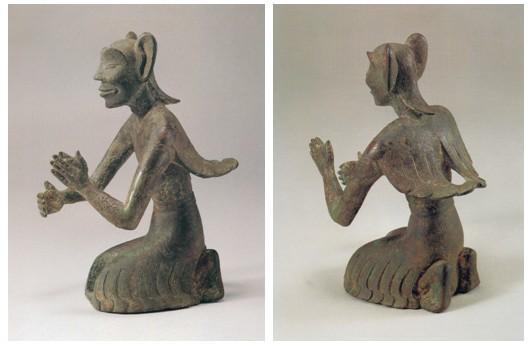
Over the next few hundred years, the appearance of immortals gradually morphed into humans that fly by floating, standing on platforms of clouds, or riding birds (often cranes)/mythical creatures.
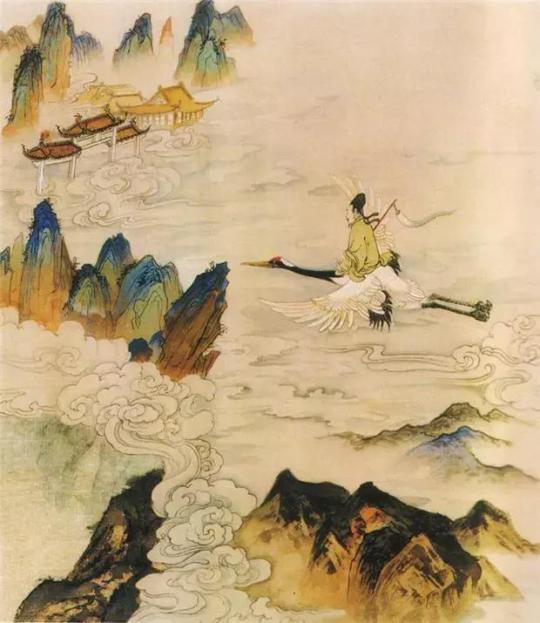
In the drama and the animated series, 仙 is often used as a descriptor in different words (ex: 仙门, 仙家, 仙侣, 仙缘…etc), rather than a standalone noun. However, it is still a reference to this general idea of training/cultivating oneself to become something greater, and provides a strong connection to Daoism.
“Cultivators”/修士
In Daoism, this term is used less than 道士, but it still means “cultivators of Dao” (修道之人), or simply, “Daoists”. In The Untamed/MDZS, of course, it means practitioners of a “cultivation”/“path”.
“Golden core”/金丹
This one has roots in real life sects of religious Daoism. The translation “golden core” itself is quite literal. “Golden” from the descriptor 金, and “core” for 丹, presumably because it looks like a sort of core. In reality, 丹 is quite hard to translate. Stanford Encyclopedia of Philosophy translates 丹 as “alchemy”, so I will use “alchemy” for 丹 from here on out. In religious Daoism, there are two types of this alchemy: external and internal, and both are supposed to help one towards immortality. People who practiced “external alchemy”/外丹 basically made “immortality elixirs” (in reality it wasn’t a drink like “elixir” implies, but a ball-shaped chewable) in the hopes that it would give immortality to whoever ate it. This is very much like alchemy in Europe, except instead of trying to turn things into gold, people were making things to eat for immortality. Some fun facts: these elixirs frequently contained heavy metals like mercury and lead, and ironically would shorten people’s lives instead of helping them live longer; also legend has it that an explosive attempt to make elixirs actually led to the invention of gunpowder.

(these appears to be actual products of external alchemy found in an Eastern Jin dynasty tomb, well-preserved due to its high mercury content)
This external alchemy obviously does not apply to “golden core” in The Untamed/MDZS, so let’s look at internal alchemy. “Internal alchemy”/內丹 is much more abstract than external alchemy, but in simple terms it is the practice of using meditation and similar strategies to return oneself to a state of emptiness (kind of like “one with nature”). This is probably what the show’s “golden core” was based on. Also another name for “internal alchemy”/內丹 is “golden alchemy”/金丹, literally the same characters as “golden core”/金丹 in the show.
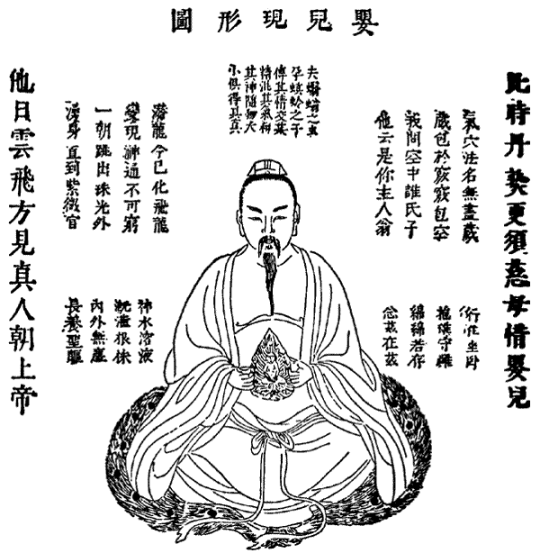

There is one major difference though. While real practitioners of internal alchemy believe that everyone already possess a “golden alchemy” (“golden core”), in the show everyone has to “cultivate” themselves in order to have one in the first place.
I love that we’re still learning shit about this world we’re in. Spiders sing? Fish chirp and enjoy tummy rubs? Trees feed each other? Mushrooms can talk. Rats giggle. Crows play games. If you leave a hamster wheel in the woods, mice will run in it. And despite all focus on the contrary, if you leave a handful of human beings alone with the opportunity to do good and be kind, they will. I love this Fucking planet so damn much
“Thinking is the most unhealthy thing in the world, and people die of it just as they die of any other disease.” - Oscar Wilde, The Decay of Living
Grey Tree, Piet Mondrian, 1912
Post link
“I went to the woods because I wished to live deliberately, to front only the essential facts of life, and see if I could not learn what it had to teach, and not, when I came to die, discover that I had not lived."
More on contemplative ecology from Thoreau→
↝ https://unityinplurality.blogspot.com/2020/01/walden-pond.html ↜
Post link

Affirmations.
You can do this! ✨
@mudecartoon
How does one grasp
That which one cannot grasp?
How does one understand
That which is without limitation or form?
One can understand water without holding it.
Allow it to slip through your fingers.
Immerse yourself in its embrace.
Drink deep, and be replenished.
I’ve been broadening the scope of my research lately and want to start posting more often, so I figured I’d give a short overview of a Taoist concept called the Three Treasures.
The core idea of the Three Treasures is that your existence is tied to energy which exists along different wavelengths. That’s a concept that I think would include a lot of different kinds of energy, but for now, we’ll focus on the three.
Jingis the energy that’s innate to your body in a biological sense, a much more coarse, dense, low-vibration state. It’s the root of our vitality and the physical substance out of which our life unfolds. A good analogy I’ve found is that jing is a candle’s wax and wick, or the hardware of a computer.
Qi is the more famous of the three energies, and is that which animates your body. This is what qigong practices interact with, and it is what allows movement of all kinds, ranging from the circulation of blood to the simple act of walking and breathing. Qi is the flame of the candle, or the electricity that powers a computer.
Shen is the energy of our spirit or mind, in the largest sense. Shen is the spiritual radiance that can be seen shining through someone’s eyes, the glow of loving-kindness, wisdom, and enlightenment. If jing is the wax and wick of a candle and qi is the flame, then shen is the light that brightens the room — and if jing is the hardware and qi is the electrical current, then shen is the software which lets a computer really do its thing.
The ultimate objective of inner alchemy in Taoist thought is to transform jing into qi and qi into shen, and ultimately reach a stage where they cyclically generate each other to allow for immense vitality.
I’ll be sharing methods of attaining this as my research progresses! For now, I hope you all enjoy this food for thought.
May the Tree of Life always shelter you!
Zen and The Art of Transition
Hullo loves! So, I’ve been in a contemplative mood lately…
If you know me, you know that I’m am an amateur theologian and to that, I find myself applying many of the theories and philosophical excercises I have learned over the years to my experiences since coming out.
Lao-tse once stated: “The more one interferes with the natural balance of the universe, the further away harmony retreats to the distance.”
I’ve been chewing on this for a few days now… these are my thoughts:
Being born trans, one is inherently out of balance. So our nature therefore, is a long journey in search of the balance which would align us with our true natures.
In short, we seek harmony.
It has been noted that the more we force situations to conform to our will, the more trouble, stress, and anxiety we encounter. Heavy or light, masculine or feminine, fast or slow, everything has its own nature within it, which cannot be violated without causing difficulties.
Essentially, when abstract and arbitrary rules are imposed from the outside, struggle is inevitable. This then sours our life experience.
Hmm.
Dear stupids of the world,
I am in state of evolution. I am becoming. Moving forward to a place that is greater than the sum of my parts so, please keep you’re abstract, and arbitrary rules to yourself.
I will not allow you to sour my life experience anymore.
With love,
Felicia ❤

“The Vinegar Tasters”
We see three men standing around a vat of vinegar. Each has dipped his finger into the vinegar and has tasted it. The expression on each man’s face shows his individual reaction. Since the painting is allegorical, we are to understand that these are no ordinary vinegar tasters, but are instead representatives of the “Three Teachings” of China, and that the vinegar they are sampling represents the Essence of Life. The three masters are K'ung Fu-tse (Confucius), Buddha, and Lao-tse, author of the oldest existing book of Taoism. The first has a sour look on his face, the second wears a bitter expression, but the third man is smiling.
Under Confucianism, the use of precisely measured court music, prescribed steps, actions, and phrases all added up to an extremely complex system of rituals, each used for a particular purpose at a particular time. A saying was recorded about K'ung Fu-tse: “If the mat was not straight, the Master would not sit.” This ought to give an indication of the extent to which things were carried out under Confucianism.
To Buddha, the second figure in the painting, life on earth was bitter, filled with attachments and desires that led to suffering. The world was seen as a setter of traps, a generator of illusions, a revolving wheel of pain for all creatures. In order to find peace, the Buddhist considered it necessary to transcend “the world of dust” and reach Nirvana, literally a state of “no wind.”
To Lao-tse, the world was not a setter of traps but a teacher of valuable lessons. Its lessons needed to be learned, just as its laws needed to be followed; then all would go well. Rather than turn away from “the world of dust,” Lao-tse advised others to “join the dust of the world.” What he saw operating behind everything in heaven and earth he called Tao (DAO), “the Way.”
I finally found a copy of the Vinegar Tasters, had it framed and put it up.
Post link







